#Their existence depends on things aligning and overlapping in a certain way
Explore tagged Tumblr posts
Text
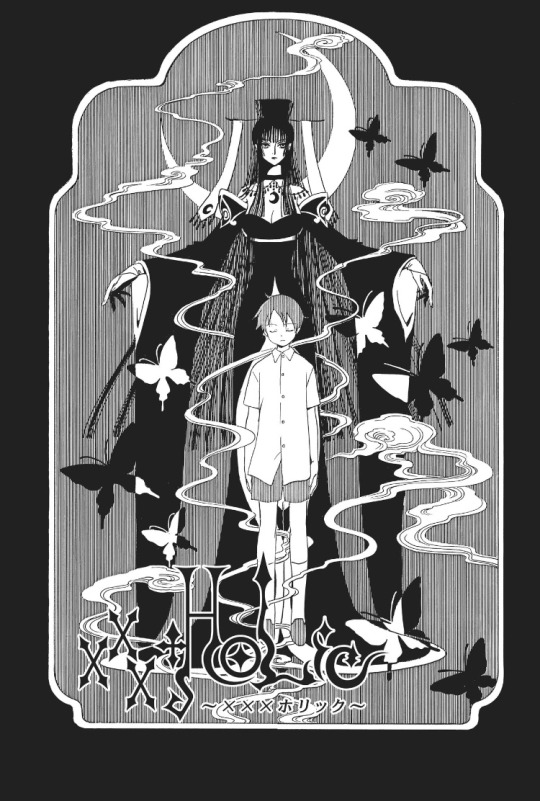
[1]
Here we are in xxxHolic: Chapter 87ish!
And eeeeee we have the moment of Watanuki’s creation! The moment where Lava Lamp’s wish resulted in Watanuki’s sudden existence! A moment that we already saw happen in Tsubasa, but would be wild to try and figure out without that.
And most importantly we see the moment of Yuuko defending him. She has her arms outstretched to either side of him, sheltering him within her grasp. He is in soft greys, while she is in stark black. His eyes are closed, head slightly tilted, while Yuuko looks directly ahead, her gaze firm. Both of their existences are abnormal - he has only just been born, but she uses her strength to shield him from the forces that would use him for their benefit and leave him with nothing. Yuuko has made a place for Watanuki within existence itself, just as her gesture here shows that he has a place with her in this moment (as well as later). And her little smoke trails wind around her and Watanuki both, showing that their fates are wound together and intertwined.
It’s a 10/10 moment, no notes no flaws, only endless admiration.
#And Watanuki doesn’t even know!#He doesn’t know that she was there for him from the very moment he existed!#She stood up for him before anyone else even knew he was real!#She has ensured his existence even when she knows her own is running out!#Oh Yuuko what will we do without you#Not liveblogging the reservoir chronicle#xxxholic#xxxholic 87#Watanuki#Yuuko Ichihara#And those butterflies that are doing the thing again#Where they phase through both the background and the clothing#They exist in multiple layers of existence at the same time#Or they exist between existences#Their existence depends on things aligning and overlapping in a certain way#Just like Watanuki!
38 notes
·
View notes
Text
Cosmetic Packaging Design Ideas 309+ Greatest Magnificence Brand Id Designs 2023
The rebranding of merchandise could have an effect in your goal market. This would imply that people will now not be succesful of join with your new model when you don’t do it proper. Contact Aventive Studio right here to speak with our inventive director about how we are ready to align your brand strategy, packaging design, and visual id to your revenue goals. BRAND ARCHITECTURE — The product assortment and group of the merchandise you provide ought to reflect your beauty branding goals in a way that's appealing to your target audience. What are the gateway merchandise that new users try when learning about your model for the first time
?
Make certain your salon web site is user-friendly, SEO oriented and contains all of the related data. Create a space branding which can calm area, mild soothing colors, gentle lines and simple furnishings that isn’t too busy. Make positive correct house branding and its environment will all the time create a positive experience for your shoppers. The model name depends upon the character of the beauty parlour if it is high-end, stylish or budget-friendly. But total, the model name of the salon ought to convey a brand story of why they exist, quirky but straightforward and sensible names are most popular.

Successful loyalty applications are about extra than just discounts; they provide exclusive beauty branding, early entry, and personalized recommendations. Brands are ensuring that their elements are ethically sourced, emphasizing truthful commerce practices and supporting native communities. The magnificence business is steadily moving past gender binaries, recognizing and catering to the wonder needs of all genders. At first glance, it appears like some other lettermark logo however observe intently and you’ll discover that it’s strewn with fascinating details. It additionally consists of optimizing the website for search engines like google and evaluating the efficiency of all advertising initiatives. A thorough understanding of those factors will allow you to make informed choices about product development and positioning.
We additionally contemplate what has become the trade standard that we have to offer so as to be at parity among the competition. This step involves making a cohesive and distinctive visual and verbal illustration of your model. This consists of designing a singular brand logo and deciding on acceptable colours, typography, and graphic components that align along with your model character and resonate together with your target market.
To improve your beauty brand’s engagement, you must come up with completely different social media campaigns like giveaways, challenges, and polls that provide audiences rewards and incentives for participation. Building a novel and memorable name in your magnificence establishment brings more advantages than simply brand recognition. It plays an necessary function in setting your beauty firm aside out of your rivals and provides you a aggressive benefit. Cosmetic branding is the artwork of crafting an enchanting persona for a beauty company or product line, entwining aesthetics and emotions to create an unforgettable expertise for customers. As a beauty brand, one of the most important things you are capable of do to make your brand stand out is to create a unique and attention-grabbing design.
Influencer collaborations aren’t just about product endorsements anymore. Social media isn’t only a platform; it’s a powerful influencer shaping beauty developments, preferences, and buying decisions. Named after its founder François Nars, NARS Cosmetics is a daring and exquisite brand with a daring logo that complements its philosophy. [newline]The overlapping letters type the distinctive and distinctive function of the NARS Cosmetics logo. The lightweight sans-serif font used in the emblem ensures that the legibility of the letters stays intact regardless of the overlapping.
Certain products do higher than others in numerous channels because of the mindset and values of the target audience buying there. For instance, the product providing, positioning, and pricing bundles for merchandise ready for a consumer at Whole Foods would possibly look different from the assortment at Ulta Beauty. This does not mean big modifications to your beauty branding, but small strikes that still uphold your brand architecture could make a giant distinction.
Packaging is the first thing prospects see when deciding whether to strive a new magnificence product, so it’s important that your product packaging captures consideration and stands out from the competitors. When Fenty Beauty launched, it immediately stood out and attracted consideration by creating foundation colours in 50+ shades for customers. This stuffed a market need and aligned with the brand’s inclusive “Beauty for All” tagline which positioned Fenty Beauty as different from its opponents in a constructive way. Attractive packaging design is a motivating drive in encouraging individuals to make impulsive choices. Taking advantage of this reward-seeking conduct with a good design can have a powerful influence on customers’ receptiveness to your products. If you want a tremendous cosmetics model that stands out from the competition, work with knowledgeable designer.
With consumers becoming extra ingredient-conscious, brands are focusing on “clean” formulations—free from parabens, sulfates, and other perceived harmful chemical substances. It’s about pioneering formulations that cater to evolving skincare or beauty wants. Showcasing before-and-after photographs or transformation videos of real shoppers using the products could be extra impactful than any professional commercial. Successful collaborations are these rooted in authenticity, the place the influencer genuinely resonates with the brand’s values. Influencers typically collaborate with manufacturers to launch curated collections, including their private contact and increasing the brand’s attain.
So, there are tons of issues that have to be accomplished to start branding. Notably, some simple questions that help you present a transparent perspective about your branding prospect. They will provide priceless insights on your way to developing influential branding within the mainstream. A beauty brand's brand is certainly one of its most necessary advertising instruments aside for the packaging design.
In this realm the place aesthetics and emotions reign supreme, every little thing begins with a wonderful model identification. If you want your cosmetics brand to succeed, your audience must have a constant expertise of your brand wherever and however they encounter it. Your brand needs to be consistent across your website, social media, influencer partnerships, packaging, product quality and brand. Every component that represents your brand must be aligned with a consistent brand technique. The reply starts with brand positioning and ends with objectively evaluating the brand values and stories communicated visually versus verbally.
Customers need to know what components are concerned and the place they’re coming from. The extra natural or natural they're, the extra probably they're to be coveted by the sweetness market. Today, many beauty patrons spend a lot of their time within the digital market. We cover this extensively in our information on how to start a clothing model or clothes line.
Online, customers yearn for content material that gives schooling, trust, and intrigue. Ensuring that your beauty branding touches upon all three of those areas not solely removes limitations to buy, however it could possibly also construct white space on your magnificence branding among the many competitors. A well-developed brand identity creates consistency throughout all model touchpoints, builds brand recognition, fosters emotional connections with customers, and units your cosmetics brand apart in the market. To create a marketable model identity, think about creating a unique and memorable model name and designing a visually interesting and recognizable emblem. The very first step in building a brand is to outline your new purpose.
Solitaire Jewellery is a independant manufacturing jeweller who has two areas in Victoria Australia. We pride ourselves on ensuring our purchasers receive only the most effective service offering and expert diamond advice. Our product providing consists of high finish luxury engagement rings, wedding bands and different jewellery wants. See our instagram @solitaire_jewellery and facebook for merchandise and designs. Beauty branding is born by figuring out what unique positioning and providing you've available in the market. A distinctive model positioning, or Brand Value Proposition, emerges from the distillation of a model audit, aggressive audit, and consumer research.
A fun, quirky, energetic brand that desires to create an city comunity for town woman that loves a coastal vibe. Witty, relatable, sensible and with a candy tooth for a great pun and an additional glass of wine. This includes providing exceptional customer service, personalizing interactions, and actively participating with customers through varied touchpoints. By nurturing relationships, you can foster buyer loyalty, generate repeat business, and profit from positive word-of-mouth suggestions. The mark combines the modern twist of PP Editorial New Ultralight, a traditional serif with a contemporary flair, with slight modifications to the 'K' for enhanced distinctiveness. Adding PP Mori Regular contributes to sophistication and clarity, ensuring that informative text on the packaging stays legible.
All of those elements are a key a half of launching a successful cosmetics model. Before you launch your cosmetics line, you need to have them all designed and in a position to go, guaranteeing they’re all an correct representation of who you might be as a brand. Nothing says "unique" like customized magnificence branding designed just for you by an expert designer. We’ve collected some wonderful examples of beauty model identities from our international community of designers. Get inspired and begin planning the proper beauty brand design at present. To create high-quality products, contemplate investing in research and improvement to create progressive, high-quality, protected cosmetics merchandise that meet your customers’ wants and expectations.
The typography reflects timeless elegance and fashionable aesthetics, mirroring the brand's ethos. Each winner drove beauty's expansive development of their specific market segments, from Charlotte Tilbury to P&G Beauty's prolific hair brand portfolio. Choose from our assortment ofresults-driven product formulations and unique textures that can delight your clients and keep them coming back for extra.
This may be tough to do at first, but it's the very basis of successful rebranding.Your new function will help you define what your products need to be in order to obtain your new brand’s goals. It is the reason why folks will buy your product and why they may keep coming back for more. Attention to detail is crucial in cosmetic branding; even the most minor details can considerably impact a brand's general feel and appear.
Find and rent a designer to make your imaginative and prescient come to life, or host a design contest and get ideas from designers all over the world. With all of the components in place, constructing a profitable brand becomes easy. As a player in the cosmetics market, you need to learn to be both constant and flexible.
The price of launching a make-up brand varies depending on your particular wants. Factors such as the dimensions and scope of your project, sort of product you might be creating, price range for advertising supplies and different sources will all have an effect on the general price. • Social media campaigns – Utilizing influencers and creating content material on social media platforms to achieve more potential clients. Nowadays, it is important to have a strong advertising strategy to build brand consciousness and attain more clients. You might wish to think about hiring knowledgeable graphic designer to create the packaging design for your new cosmetics model.
In 2020, every model wants a presence on social media, however it’s especially important for magnificence brands. Once you’ve answered the core questions on your brand the subsequent step of the branding course of is constructing your brand identity. The first part of that process is to define your design building blocks.
Brands that adapt thrive, while those that resist typically discover themselves fading. Selena Gomez’s Rare Beauty emphasizes self-expression and redefines magnificence standards, resonating with a lot of her followers and past. Fenty Beauty’s launch revolutionized the business, not solely due to its inclusive shade range but additionally because of Rihanna’s highly effective affect and commitment to the model.
We goal to become a family name that people look ahead to inviting into their properties each month. In the long run, we plan to add whole-food, natural dietary supplements as nicely. DISTRIBUTION CHANNELS — Where your products can be found for purchase is as essential because the product assortment itself. Today’s beauty branding consumer is purchasing throughout all channels and a savvy magnificence brand company is aware of tips on how to develop product and consumer demand to assist all channels.
Nothing says "distinctive" like custom cosmetics branding designed only for you by a professional designer. We’ve collected some superb examples of cosmetics brand identities from our global neighborhood of designers. Get impressed and start planning the proper cosmetics model design today. Both brands are in the same area but have fully totally different approaches to building their model identity. The model on the left makes use of bright and heat colours to project a way of liveliness whereas the brand on the proper makes use of clean and monochromatic designs to level out a way of purity. Successful beauty brands perceive the significance of fostering a group and nurturing an ongoing relationship with their prospects.
By creating engaging co-branded beauty campaigns, you'll have the ability to leverage the strengths of the partnerships to grow your loyal audience base and model visibility. Creating a gorgeous and powerful cosmetic model design could be important to the success of a cosmetic product. The beauty industry is an evergreen trade that is booming, and much cash is being made in the magnificence markets. The preferences of your target will influence your packaging, colours and fonts, content tone, and the marketing efforts you use to get your brand in front of your audience. VIVA SKINCARE is a model of premium cosmetics specialised in skincare and sweetness of women with a spread of merchandise of the very best high quality.
0 notes
Note
Hey! I don't know if it's been asked before, but does the elemental system in the RPG tomfoolery have significance, or is it just an RPG trope? (The five elements, not Light/Dark)
On its own, it's basically just an element system, which I'm fond of working in stories. I tend to have them, and I tend to try and keep it to a relatively small number of elements to prevent overlap and keep things each having a fairly strong identity.
But also, because I just like elemental metaphors for characters. I like the natural world and I like fantastical contexts where force of nature go brrrr.
If there's a deliberate quality to my playing-with-assumptions about it, it's that I didn't want to leave anybody at "neutral" or "normal"- whether or not they have an active magical gift, the way they experience the world is affected a lot by things. I tend to want to create magical systems with an angle that no two people are getting the same results the same way; even if you can standardize things, like in mathematics, everyone's relationship with math- how they visualize and manipulate numbers- is unique.
And even people with the same alignment experience things fundamentally differently! Both Argent and Taylor are water-dark, but in Taylor's case, their relationship with water is a relationship inevitably with blood, and with warmth. The island Taylor comes from is isolated in an arctic sea and frozen over the majority of the year. When Taylor loses everything and becomes undead, what they retain is blood- the only real flesh they have left is bone marrow, which is responsible for producing blood.
On the flipside Argent is a person from a relatively temperate landlocked country where half his ancestry comes from tropical wetlands he's never personally seen. His attention and attitude leads him to focus on extremely small amounts of water, both in the sense that he's kind of a detail-finicky closed off person, and that to a certain degree, his identity is kept very close to his chest.
Taylor and Argent are people who have a lot of conflict because they're people who have some very strong opinions on the same subjects, but also, enough different that they do not see things the same way. That shared element is almost more a point of conflict to them than anything.
Side ramble about the system itself under a cut:
So the element system in RPGverse is earth-air-water-wood-fire, which I based a bit off of wuxing, albeit only superficially. I don't have the complex succession or elemental interconnections, but the five elements and the inclusion of wood as distinct from earth both appealed to me, so I drew from that.
I then swapped out 'metal' for 'air', because when I'm just playing with my own imagination it's a bit of a struggle to differentiate earth from metal when one has already separated wood off into its own thing. (A struggle, but admittedly not impossible- I did it in Lornwood, which has a six-element system)
I guess the significance of this kind of two-tiered element system is that the conflict of light vs. dark has predominated this setting heavily, but if we're talking about 'good and evil' those things cannot exist in a vacuum. They are inevitably dependent on other things. And yeah, we might say, 'well, what the heck is an Evil Rock, or an Evil Fire', but arguably, we really think of it that way!
Wildfires bad, hearth fires good. (even though a hearth fire can scald a child or burn down a house, even though small burns are part of a forest's ecosystem and we're kind of in a situation in many parts of the world for extinguishing any small fire and thus preventing them from exhausting the supply of detritus that could be kindling to a much larger one)
Pretty lake you go boating in good, irrigating rain good, storm on the same pretty lake or flooding rain that gorges the rivers bad.
We often view evil as something that acts parasitically through the natural world around us, that there's an evil state and a holy state of natural materials. And of course, because I'm looking to this specifically for RPGverse which is asking a lot of questions about good and evil, and what things we assume are good or evil- grabbing that as a conceptual springing-off-point and running with it helps me dig the story's themes a bit deeper into its lore.
#rpg tomfoolery#readmore#I think sometimes about the paired chapter titles in Lord Of The Flies#'beast from water' and 'beast from air'#as these kids are struggling more and more they're trying to reconcile where the evil is coming from#the miasma theory of disease- 'miasma' is almost literally 'bad air'#a suspicion of the elements as roads to evil and a sense of need to imbue holiness into them underpins many early spiritualities#and why shouldn't it? before we had the means to see or understand bacteria viruses and many forms of parasites#these things were demons#we still could see that SOMETHING was happening#how we might now describe something clinically in terms of sterility#was once the domain of spirituality to argue.#why did you get cholera? the beast came by water.
16 notes
·
View notes
Photo


Ravnica for Goblins
Alignment
Figuring out where on the spectrum of beliefs, morals, and neutrality your character falls can be a challenge. One individual’s Chaotic Good is another’s Lawful Evil. To help clarify things, most campaigns include alignment for significant NPCs, and one can often draw a line between that NPC and that alignment. This doesn’t apply to every NPC, but the more important someone is, the more they come to represent a specific section of the moral grid in a campaign.
Ravnica does this as well, with most of the alignment chart represented by a Guildmaster. This isn’t completely uniform, however, so there’s wiggle room for an NPC to lean one way or the other as fits the story. There are some pretty safe bets, however, who can be counted on to check certain boxes at all times.
Isperia of the Azorius Senate: Lawful Neutral
Isperia represents the goal of the Azorius; objective devotion to upholding the laws as they are written. She was elected to her position because of her ability to look passed right & wrong, instead focusing solely on interpreting Ravnica’s 10d6 of Psychic damage legal system for all disputes.
Lazav of House Dimir: Neutral Evil
Lazav is the Dimir at their most annoying but least murderous. Blatant disregard for everyone’s privacy, but preference for stealing, secrets, and information over assassination. Lazav infiltrates every Guild, including his own, always determined to stay several steps ahead of any potential threat. This is not to say he won’t kill people if necessary, but his is a cold, “bloodstained calculus” methodology. It’s never personal.
Rakdos of the Cult of Rakdos: Chaotic Evil
On this plane, Rakdos is the living embodiment of Chaotic Evil, a title he takes very seriously. It’s just about the only thing he takes seriously, as he prefers to live without rules and have everyone else do the same. Unrestrained hedonism and mayhem are his bread & butter. You do what you want, whatever you want, whenever you want, however you want, regardless of what anyone or anything else says. No restrictions, no inhibitions, no hesitation. Encouraging this kind of destructive chaos in the streets is the only thing keeping Rakdos from embracing more orthodox Chaotic Evil behavior of slaughtering millions, enslaving thousands, and bowing to no one.
The Obzedat of the Orzhov Syndicate: Lawful Evil
Hard to believe there can be something worse than an actual Demon given permission to encourage every sin imaginable, but that is what the Ghost Council are. The Obzedat exist to stretch, bend, and twist every law designed to maintain order, neutrality, or justice so as to benefit themselves. What’s worse is how the Orzhov play innocent when they do it. Unlike the Dimir or the Rakdos who accept and even embrace society’s interpretation of their actions, the Orzhov refuse to be seen as anything but humble, spiritual, gracious public servants. The very antithesis of what they actually are; arrogant, miserly, manipulative bastards. They will point out exactly which laws they are not breaking, which laws there is insufficient evidence to prove they are breaking, and which laws prevent you from punching them in the face right now.
Trostani of the Selesnya Conclave: Neutral Good
If there’s one thing to be said for Selesnya, it’s that they are rarely the problem. The Conclave is perfectly content to keep to their fields & forests most of the time and focus solely on building up their own Guild. In a city where every Guild has a problem with every other Guild, Selesnya is the only one who at least tries to get along with everyone else. They don’t tend to get involved in matters that don’t concern them, but theirs is always a safe haven for those who seek it. Trostani is made up of three dryads representing Harmony, Life, and Order. You don’t get much more Neutral Good than that. The only problem is that Trostani basically never leave their Guildhall, so their influence only spreads so far. The reason they can live so peacefully is because so little of the chaotic city life overlaps into theirs.
Besides them, everyone has wiggle room and gray area to move around in. Both Niv-Mizzet and Borborygmos are canonically Chaotic Neutral, but with their most prominent personality traits being vanity & anger, respectively, the “Neutral” part of that can go out the window quick. Still, almost every Guild has at least a semblance of a position somewhere on the chart to start from. You can basically count on a member of each Guild to be at least:
Azorius Senate: Lawful
This is the Guild that writes the laws of Ravnica, after all. They literally draw their power from this ancient legal code, so it makes sense that, whether an Azorius leans more towards Good, Evil, or Neutrality, they do so lawfully.
Boros Legion: Good
If the Azorius follow the intellectual letter of the law, the Boros follow the passionate spirit for which said law was originally written. Justice, not legal-ese. Sometimes the law is good enough, but sometimes it fails its citizens. A Boros should be an inspiring force for Good, whether Lawful or Chaotic depends on the individual.
House Dimir: Neutral
The best a Dimir operative can hope to achieve, morally speaking, is neutrality. If you are working for this Guild, you are lying & stealing. Odds are you are infiltrating another Guild to find/steal information to report back to your superior(s). Not every Dimir agent does this willingly, however. Maybe a character only became a Dimir operative after finding out their mentor was. Maybe a character had nowhere else to turn and no one else to depend on. Maybe they just needed House Dimir’s connections to get them close enough to someone in another Guild who wronged them. Whatever the motivation, cling to that gray area of neutrality like your life depends on it. It’s all you’ve got.
Gruul Clans: Chaotic
Gruul are many things. “Lawful” is not one of them. If you’re a member of a Gruul Clan, you’ve definitely got a bit of a temper on you and a strong disregard for authority. Now, a Gruul can absolutely be a force for good, or, conversely, evil. Maybe you joined the Gruul after your ancestral home was bulldozed over for a smelly Izzet facility. Maybe you had a mental breakdown after decades of trying to uphold law in a city where the laws mean jack shit unless there’s a guy in blue sitting at his desk. Maybe you got tired of planting trees and getting stepped on. Maybe you don’t like the pretentiousness of so-called “artists”. Maybe you just like hitting things. Whatever your reason, the Gruul will welcome another anarchist.
Golgari Swarm: Chaotic/Evil/Neutral
The Golgari Swarm are the first Guild where you’re really going to find a lot of diversity in alignment. Some definitely fall into the chasm of Chaotic Evil Necromancers, others stand firmly in the fields of True Neutral Rot Farmer, and some idly wander between the two. Necromancy is pretty normal in Golgari society, and “Evil” can be considered a harsh word to describe it. It’s definitely more normalized in the Undercity than it is on the surface. A lot of typically Evil behavior is like that for the Golgari, lest we forget that this society of giant bugs, necromancers, zombies, medusa, etc also run the sewage system and food stamps program for the city. That said, there are definitely Golgari with sufficient ambition/motivation to become ready-made Big Bads. What is a Lich, after all, but a wizard who says, “No, I’m too important to die!”
Izzet League: Chaotic
If there’s one predictable aspect of the Izzet, it’s that they are unpredictable. For a Guild whose founding principle is “I wonder what would happen if....”, it’s best to accept that you’ll never be Lawful. Your job, as it is, is to look at laws (nature, physics, etc) and poke at them with electrodes to see what happens. Your focus will always be on things that haven’t been written down yet, as opposed to what already has. It’s almost literally impossible to be Lawful and Izzet for that reason alone. As far as Good, Evil, and Neutral go; that’s up to the individual. This experiment could replicate food so we never have to eat Golgari rations again! Or it could replicate essential personnel to prevent understaffing! Or, it could even replicate.... ME (cue maniacal laughter).
Orzhov Syndicate: Lawful
The Orzhov, like the Azorius, draw their power and influence from the laws of Ravnica. Evil is expected, though not mandatory, but Lawful is a requirement. An Orzhov who doesn’t know their way around Ravnica’s laws is a loose end, and the Orzhov don’t allow loose ends to jeopardize their schemes & ambitions. One can absolutely be a Lawful Neutral Orzhov, also known as an Accountant, but such individuals rarely find their way into a life of adventure. A Lawful Good Orzhov can exist, but your greatest adversary will be the large majority of your Guild who sees you as a potential threat to their illicit activities. In which case, you’ll want to know those laws even better than they do.
Cult of Rakdos: Chaotic
Chaos is mandatory, evil is encouraged. By “Evil”, we mean “things people tell you are Evil”. Anything you would do while drunk you should be able to do at all times! There’s really only three rules in the Cult of Rakdos:
Rule #1, Rakdos is #1
Rule #2, JUST DO IT
Rule #3, Don’t be boring
Being Neutral breaks Rule 3, being Good breaks Rule 2 and/or 3, and being Lawful breaks all 3 rules. Which reminds me of the fourth rule:
Rule #4, NEVER break Rule #1
Truthfully, being Chaotic Good or Chaotic Neutral is perfectly fine as long as you don’t impede on someone else’s hedonism without a reason, or lack thereof. As long as you’re being free & crazy, that’s what really matters.
Selesnya Conclave: Good
As stated with Trostani, Selesnya is a pretty consistent force of Good, if nothing else. They don’t really do hate, you know? Life in the Conclave is pretty uniformly Good, so why make trouble? Why can’t everyone just be Good? In short; ‘cause they don’t wanna, none of your business, go hug a tree, and/or because fire is FUN. Lawful fits some individuals but can just get in the way for others. Neutral is pretty solid but some things must call you to act. Chaotic is if you really want to embrace being a Nature Warrior in a planet-sized cityscape. Selesnya is the Guild for goodie two-shoes, as if that’s a bad thing.
Simic Combine: Any
The Simic Combine is the one Guild that can honestly fall anywhere on the alignment chart. The Guild started out as Doctors, Naturalists, and preservers of life. Now it also operates large-scale bioengineering. You can have a Lawful Good Simic Paladin committed to preserving life and health, a True Neutral Simic Forcemage (Druid) dedicated to living a simple life bolstering plant growth, or a Chaotic Evil Simic Wizard who has decided on everyone’s behalf that flippers and gills are now mandatory. Just like science can be used for great Good, great Evil, or mundane routine, the Simic Combine can turn its experiments to any purpose, depending on the individual. And whereas the Izzet are firmly Chaotic, the Simic have the foresight to think ahead before they try an experiment. You can be anything you want in the Simic Combine, just plan it out.
#ravnica for goblins#ravnica#goblins#d&d#dnd#5e#alignment#roleplaying#dungeons and dragons#dungeons & dragons#good#evil#lawful#neutral#guilds
140 notes
·
View notes
Note
i have something in common with sjm and that’s reusing characters. i have a certain type of female character (ambitious, ruthless, loyal) and male character (untrustworthy but well meaning and polite) that i really like writing and no matter what i’m writing and how i originally imagined the personality of the characters, my main female and male characters slowly morph into what i described, which was fine for the first two short stories i wrote but now it’s an actual problem. any advice??
Well, I think the problem with SJ/M is that she rushes to get her drafts printed rather than taking her time to distinguish the characters. For example, I think L/ucien and Kale are rather similar in their broodiness and angstiness and the general way in which Mess uses them (for diversity points and discarding them for more boring sexier characters). They are both loyal to a corrupt state, they both have family baggage, and they provide friendship to the main character. But if Mess played up their differences and she could focus when it comes to developing characters who aren’t in her main ships, it wouldn’t be so obvious. I too fall back on stock characters, as I think everyone does once they’ve been writing (especially on one WIP) for a little while. It’s like how visual artists have same-face syndrome if they don’t practice with diverse references. When I was doing my writing major, I had to write two-three short stories/one-acts per year, so I ended up falling into a certain kind of character. Looking back on what I’ve written, I realize now that even though they started similarly (something along the lines of bitter or guarded), they ended up different. What differentiates them is their experiences, their dynamics with other characters, and their narrative voices. While two of my characters from different WIPs may react in the same way to a certain event or possibly even overlap in their dialogue or values, they still have different goals and exist in different contexts. That said, I definitely try to expand my horizons because there are so many people I’m interested in writing about. For short pieces, variants of stock characters work for me. Long things, not so much.
If I find myself leaning heavily on my stock characters when creating a new cast/character, I try to think about why I’m interested in (and in some cases, dependent on) this kind of characterization. Then I figure out how to expand on it. I find it very helpful to compare and contrast all the different variants of the stock characters as well, and further differentiate them through both little and big methods (ie giving them dissimilar favorite foods vs giving them opposite character flaws or family setups or life privileges). I spend a lot of mental/emotional time and energy with each individual primary character by writing out character profiles, outlining their backstories, figuring out their character alignment, their Hogwarts house, hell even their Divergent faction if that helps. And finally, I of course observe similar characters I’ve liked in media, and I might even try to emulate the interesting qualities in the people around me. I wouldn’t base a character solely on a person I met/know, because that’s just impossible and kind of presumptuous for me personally. But I do write notes on people’s mannerisms, fashion sense, humor, tone of voice, basically all the stuff that is very often missed because we use tropes instead of the wide breadth of human behavior. Whenever you meet a really out-there person, like a weird teacher/mentor or a friend/classmate whose personality you find totally unique, use bits of that for characters. I don’t know if that helps, but that’s what I do. Tbh, you’re already on the right track. The best way to solve the problem is definitely acknowledging/recognizing that you have stock characters and then actively going against that and trying out new characterizations.
19 notes
·
View notes
Text
Alrighty, So I got through the beginning prologue of the epilogue and through the first 5 pages of Meat.
Even though I did stream my stream of conciousness on twitch, im probbaly not gonna be posting that on youtube
Instead what I’ll be doing is writing down my thoughts and notes on tumblr after I stream each time
Speaking of, the next time I will be streaming is tomorrow April 29 at about 8pm EST for about an Hour again here: https://www.twitch.tv/dahnimae
the way my life schedule is now is I can probably do this for about an hour a day after work, so I think I can get through the epilogues quickly in nice digestible chunks
At least for Monday and Tuesday anyway, after that Ill have to make sure im not doing anything else
but anyways, here are the rough thoughts I had during the epilogue, up to the first 5 Pages of Meat:
First off, I got some thoughts from Rose about how the Heroic versus Just death system for immortals is apparently derived from an emotional value of what is “Good” or “Bad”, what is good or what is bad ultimately being derived from what someone or something “feels” is good or bad, so theres some subjectivity in that judgement, which makes sense considering how individuals are able to affect that judgement in homestuck canon, Aranea proposing her own individual morality onto the clock, as well as Caliborn just destroying the clock/idea of dividing things into good or bad
because Rose describes the system of describing what is canon or not canon or outside canon as being less emotional in nature than that of the of the god tier death clock
her exact words are “Good and bad are words that don’t mean anything, beyond a certain threshold of mortal consideration.” its not said outright but its basically implied
Speaking of, so Canon is made up of three “Pillars”
Truth
Relevance
Essentiality
now, truth is easy to distinguish from the other two, it’s the idea of reality. If something is true, that means it really happened. If something is a lie, that means it didn’t happen, or it wouldn’t happen, it does not exist.
Basically an idea of Hope versus Rage
Relevance and Essentiality are a little harder to seperate, and Rose doesn’t do much to seperate them either
but Relevance is tied to an idea of Context, it’s something that has meaning or importance to what is “currently” happening, the idea of the present conversation one is having, the current thoughts someone is thinking about, the object they are currently looking at or viewing, or just the exact point of focus of the current moment in time
something that is irrelevant is something were not looking at currently, something were not focusing on, or something that’s just not improtant or meaningful right now
basically an idea of Light versus Void
Essentiality is then an idea of a “must”, and idea, no matter when or where or how it happened. It Must have happened or it Must happen in the future. Its the one most closely tied to an idea of destiny, fate, or prerequisites for a more down to earth definition. In order to grow a plant, you MUST plant the seed.
The planting of the seed is essential to the plant ever growing in that spot, if no one plants the seed, the seed will never grow, and the plant will never exist. The plant’s entire existence depends upon that seed being planted.
something that is non essential, can still be true and relevant, the plant is a rosebush, or a tree with apples, or has green leaves versus purple leaves etc but if that exact property were to change into a different one, the core requisites of it’s existence does not change, it’s seed was still planted, it still grew into a plant. (within reason of course, but how essential something is does depend upon the context for why its essential, if its essential because its roots hold the ground together in the future allowing another event to happen, then it must be a plant with strong and deep earth fastening roots, what it is and why, is relevant to its essentiality, so the two are interwoven in a sense)
Basically an idea of Time and Space, but Rose doesn’t seperate them as neatly from Light and Void (she could have easily glossed them over into a single “importance” factor, but she didn’t)
it may be that the distinction itself is needed, but not necessarily a requisite to getting John to understand what she meant.
Essential, but not entirely Relevant to her current circumstances :)
but then she goes onto describe the different combinations of those three pillars and what they are and do
Inside Canon = It is True, it is somewhat Relevant, It is somewhat Essential
Relevance and Essentiality being treated as like percentages from 0-100%, inside canon requiring nonzero amounts for both, while Truth is more black or white, it either is True or is not True
Outside Canon = True
so the amount of relevance and essentiality can be nothing, or essentiality zero, but is must be True
and then Not Canon sort of overlaps what might have been two other categories, I guess the distinction of which doesn’t really matter for now, since were dealing with what is canon, not what isn’t canon
Not Canon = Untrue, with varying percentages of essentiality/relevance
I have my own ideas of what happens to other combos within the Homestuck mythos, theyre not complete but basically as follows:
True, Essential, Relevant (Canon Homestuck)
True, Not Essential, Relevant (Paradox Space Comics)
True, Essential, Not Relevant (Hiveswap)
True, Not Essential, Not Relevant (Outside of Canon)
Not True, Essential, Relevant (”Not Canon” = The Epilogues)
Not True, Not Essential, Relevant (”Not Canon” = Fanfiction/Audience Generated Content)
Not True, Essential, Not Relevant (”Not Canon” = FriendSims)
Not True, Not Essential, Not Relevant (Not Homestuck)
That’s basically how I’m divvying up the majority of distinguishable homestuck aligned content into those three pillars anyway
Rose did also Call Truth the foundation for which Relevance and Essentiality can do their thing, and that did go into how in order for the Friendsims to flip from being not canon to really canon (Hiveswap) it just needs to flip the switch into True
same for Fanfiction of Homestuck/Audience generated content in general, flipping the switch into True makes the Paradox Space content, which is essentially ascended Fanfiction content
and then for things Outside of Canon, they have a tenuous position, because while as long as they remain True, they are still Canon, their Truth value remains conditional upon their values of Relevance and Essentiality, since the closer they dip into zero or negative values, the closer they drag True from flipping to Untrue.
To remain true, or better yet, to integrate into Canon proper, they need to prop up their Relevance and Essentiality values
They need to become the centre of attention, the point of current focus, and they need to have some impact on events in other parts of canon
and all who understand this also understand that characters inside the story don’t get to decide directly how relevant or essential they are to the story, the Audience (and the Author) do
Rose has the idea that the answer lies in the Audience and their expectations, and the audience’s expectations for any story boils down to: the Hero must defeat the Villain.
John is the Hero, Lord English is the Villain. John must defeat Lord English for those outside of Canon to become Canon once again. It’s self explanatory in both ways.
sidenote though, the way John must defeat Lord English is also hilariously self explanatory in both ways.
John will use the cursor Juju to defeat Lord English since it is the only thing that can defeat him. John won’t have to think about how to use it or when or where. Since the cursor Juju is essentially just a plot hole that John fills suddenly out of nowhere perfectly and with ease and immediately will solve the problem no real effort needed.
John will defeat Lord English using the power of a literal Deus Ex Machina. (but a Deux Ex Machina that’s been symbolically hinted at being the secret weapon all along and which the audience is entirely aware will be the thing used to defeat LE it was more a matter of when then How, making it actually a Chekov’s Deus Ex Machina. And I guess the opposite nature of those two things equals out pretty nicely, The Deus Ex Machina is exactly that, an easy and simply solution to all of canon’s ills, but it feels earned instead of handed out randomly like a Chekov’s Gun would feel earned, while simply losing the difficulty of properly using a well set up Checkov’s Gun. Best of both worlds, worst of none)
But,
Different characters seem to have different thoughts on how best to solve the problem. Characters like Dirk it seems
Dirk seems to be operating under a sort of opposite position to Rose, that instead of propping up the audience’s expectations of the Hero, Dirk wants to prop up expectations of a Villain.
Though I’ve only gotten to page 5 of Meat, it seems pretty clear that Dirk’s intentions are to make either himself or Jane a Villainous character.
The reason being is because he may be aware that people can stick to stories for various reasons, including, either liking the villain a lot, or wanting the villain to Go Down.
lots of people like Game of Thrones because of how much they hated Joffrey, I know I was that.
and so far, Lord English hasn’t actually been that much of passionately hated villain? Like that’s pretty clear to the story and characters themselves, why even go fight him? Oh because its technically necessary okay fine whatever I guess
Meanwhile, we have a figure in Homestuck that’s already a pretty untapped source of Passionate Villainy, that covers quite a lot of the bases of canon and not canon, Paradox Space, Hiveswap, Homestuck, Fanfiction, Friendsims (and I wouldn’t be passed saying probably these epilogues as well)
Doc Scratch.
And Doc Scratch is pretty much a parallel of villainy of Lord English
Because where Lord English seems to physically embody certain characters, Doc Scratch seems to mentally embody them.
Caliborn, Equius, Gamzee and Dirk.
and with all this talk of Ultimate Selves already happening, what happens when one small part of your ultimate self is tainted by this kind of existence? This being, this apparent ultimate villain, tainted by villainous desires, something you know should be rejected
Do you embrace it fully, and see no difference between this being and yourself, internally incorporating it into your ultimate self (Caliborn)
Do you submit that part of yourself to it? Essentially, “giving up” that part of yourself, excizing that slice of your ultimate self as “someone else’s ultimate self” and therefore cutting off it’s influence “Here have it, it’s yours if you want it”? (Equius)
Does your Soul get torn through it’s middle, split like a broken piece of glass? Half on one side, half on the other. A mirthful broken pair of ultimates. Dissociated from eachother enough to be considered seperate yet two halves of the whole, inseperable yet divided. (Gamzee)
Or do you allow “yourself” to be entirely overwritten by the other? Does one bad apple spoil the bunch? Does it infest and infect, slowly, piece by piece, cell by cell, like a virus spreading, changing, overlapping, until everything that was You, your ultimate self, your essential Being, is no longer what is was.
Will your Heart be Broken Dirk?
You make jokes about cutting pieces off yourself before it’s too late, like it’s the only solution. That piece of you is gone, it’s rotting, and it’s spreading fast.
But you need someone else to do it for you now. Somehow, right now, you’re not building up the resolve to cut off your own head like you might have done before. Have their insidious roots taken hold in you that deeply?
Destroy “Yourself” or be Destroyed by Yourself Dirk
But I guess it’s different when you’re just cutting off a piece of flesh representing “you”
Are you more hesitant to cultivate or destroy your ultimate self itself? To suddenly force yourself to decide what kind of person you are? How does a computer program itself while it’s running?
Ignorant of that fact that everyone is constantly doing that to themselves all the time with the choices they make, what they choose to do, or the kinds of people they decide to be?
People decide who they ultimately are with their own choices, they may not have access to directly fiddle with their ultimate selves as if it were a physical being under a microscope, but what most people do or what Dirk has the ability to do are functionally identical. He’s just overthinking it and getting too caught up in the pretentious philosophy of it all
87 notes
·
View notes
Text
Lupine Publishers | Enabling Intragenerational third places as New Incubators of Sociability and Placemaking in Times of Transition
Lupine Publishers | Scholarly Journal Of Psychology And Behavioral Sciences

Abstract
One of the most influential place theories, or conceptual frameworks that deal with the framing, activation and management (as well as understanding) of the public realm, for which the coffee shop, bookstore, taverna, bistro, bakery, pub, etc. became a metonym, was the idea of the “Third Place”: a term that emerged to describe new social environments that were distinct from both home (the first place) and work (the second place) and which revolved around leisure, consumption and the desire for the social with a lesser emphasis on the community Banerjee Tridib [1], Oldenburg Ray [2]. The full vocabulary that thoughtful public realms, intragenerational and inclusive can offer, as prime public places, is a vivid example of Oldenburg’s third place theory (1999) which he centers round a place to which person(s) are drawn into some kind of sanctuary, serenity, relaxation and refuge feeling and atmosphere. This is a place where the community feeling is being developed and nurtured (Figure 1).
Introduction
The main argument is that third places, places where people can gather, relax after work, put aside their differences, concerns of work and home, and just hang out simply for the pleasures of good company and lively conversation, are the heart of (any) community’s social vitality and are the grassroots of democracy Oldenburg R [3] (Figure 2). Third places are gathering places and their importance is in nourishing sociability. For these places to work, they need to fully enable a culture of social inclusion, multiculturalism, ethnic diversity and a balance social-mix, instead of becoming very segregated, mono cultural realms. One thing is certain: these places such as coffee houses, community centers, groceries, markets, bazaars, parks, discussion rooms, etc. are of extreme importance for a vibrant life of any neighborhood, town or city. Now on the opposite site of the pendulum, but still making sense of cities complex hybridities and constant transformations, Edward Soja’s “third space” presents itself as an extremely useful term (curiously resembling in form, though definitely not meaning, the Oldenburg Third Place). In essence, third spaces are those which overlay real spaces (the first space) and imagined spaces (the second space), both we mentioned above, to produce in something that is open-ended, undefinable, fluid, and endlessly complex (as are, Soja argues, so many contemporary urban spaces in cities). Soja Edward W [4]. Importantly, third spaces are not only physically constructed but socially and virtually constructed (Something that Oldenburg has not envisioned at all) as well: a factor which, above all, infers that they may be differentially constructed. By the way, Soja’s theory of the third space builds on Henri Lefebvre’s concept of the spatial triad Lefebvre H [5]. Lefebvre’s production of space ideas remains contentious but highly relevant for the investigation of city transformation in general and how the planning of urban space can contribute to social injustice in particular University of Minnesota Press. and Harvey D [6]. What Oldenburg describes as “the problem of place” one of the foci and key driving elements his social urban geography work, and is where Soja’s concept of third space differs most dramatically; as in third spaces, the key link between participants is not normally their location but shared links that draw people together.
Figure 1: Barber and Parlour Third Place, London, United Kingdom by Toa Heftiba. Reproduced by Permission.
Figure 2: Spaces, Place and People of Shanghai, China, Photo by Christie Kim. Reproduced by Permission.
Communities include things held in common, like government and social structure as well as a common sense of place or location. Main function of the community (local community-gemeinschaft) is to mediate between the individual and society (geselschaft), and that people could relate to their societies through both geographic and non-geographic substructures of communities Hillery G [7]. The third place is an outcry for the return to the fundamental values of a community; some which have been forgotten and erased in today’s age of fast changes, superficial values and eradicated places. The popularity of a place where new social networks are built and old maintained can never be or made obsolete. Third places have existed for hundreds of years. They wereplaces that had their appeal and that were symbols and active mediators in community communication. As Oldenburg calls them-social condensersplaces, agoras if you will, where all citizens of the community or a neighborhood meet to develop the place where citizens of a community or neighborhood meet to develop friendships, discuss issues, and interact (socially changes, positive and negative ones alike. A well-functioning public realm with a third place richness can build social capital by enforcing and melding social relations Putnam R, Lewis F [8]. This happens through in-continuo social contact among people in multiple overlapping role relationships Lennard Crowhurst S, Lennard, H [9].
These third places are crucial to a community for a number of reasons. They are firstly distinctive informal gathering places, secondly, they make the citizen feel at home, thirdly they nourish relationships and a diversity of human contact, fourthly they help create a sense of place and community and finally they invoke a sense of civic pride Oldenburg R [10]. The key ingredient lies in the fact that they are socially binding, encouraging sociability at the same time and fighting against isolation. They simply make life more joyous, colorful, and they enrich city’s economic activity, public life and democracy. The life of third places in coffee shops, cafés, hair salons, restaurants, bakeries, semi-informal meeting places, bazaars, other markets, gardens etc. are in alignment with the argument that these types of places are the facilitators of vibrant and good public life and that in most cases they are in synergy with open public spaces, like squares, bazaars and other markets. [3] points at the essential ingredients for a well-functioning third place: 1. They must be free or relatively inexpensive to enter and to purchase food and drinks. They must be highly accessible; ideally one should be able to get there by foot from one’s home; A number of people can be expected to be there on a daily basis; All people should feel welcome, regardless of their race, gender or religion and it should be easy to get into a conversation. A person who goes there should be able to find both old and new friends each time they visit. Third places are retreats into social spaces from a selfish need with those of like mind. Its where we foster some of our selfesteem, and a great deal of our social capital, that helps us survive and bridge home and work Putnam RD [11].
Freud held that emotional wellbeing depends upon having someone to love and a work to do. Oldenburg argues that we also need a dependable place of refuge where, for a few minutes a day, we can escape the demands of family and work environment Oldenburg R [10]. Third places in action, where intergenerational spirit exists, can provide possible and viable foundation for: 1) foster a sense of connection between people (of different age, gender, ethnicity, social class, sexual orientation, political or religious beliefs) 2) create temporary and permanent venues where a vibrant exchange of ideas can take place 3) encourage those ideas to lead to real efforts that bring progress to the community 4) offer an enjoyable and long-lasting social and aesthetic environment both for you, elderly and in the middle-for all geographies of age.
Built environment supports the built-up of social capital not just amongst adults, elderly but also between children. Especially for children the concept of the traditional European square offers an important learning environment. Primarily, children learn by repeated observation, imitation and practice in relating to a range of adults in multiple contexts Lennard H [12]. The disturbing lack of good public spaces in our cities, town and neighborhoods where children are able to gather and play, can have a tremendous impact on urban culture. Lack of these places reinforces the already omnipresent alienation and loss of real sense of place for children, which has to do a lot with the overuse of video, TV and other electronic media (rise of obesity levels due to lack of walking, exercise, etc.). Another problem is lack of walking and the overuse of automobile for transportation of children even on very short distances.
Because children cannot always reach places on their own, they rely upon their parents to transport them everywhere (thus the “soccer mom” phenomenon in American suburbia). The problem is also that children often play in the street and across several open front lawns. It is impossible, however, to define this area as urban space (like a public square) bounded by surrounding houses and trees, when distances between opposite houses are enormous Gehl J [13]. The common mistake is made when parks are being associated with public squares. Parks are designed with specific areas set aside for recreational activities or quiet contemplation. A typical park is an area dominated by grass, trees, water and pathways. Public squares are designed with paved surfaces to accommodate a variety of uses that parks cannot offer, including the relation to the built environment, orientation, legibility and imageability. However, both are needed in order to create livable places and one does not exclude the other. Public places (squares) have also a value to children for play. This becomes very obvious when kids learn to use their imaginations and expand their sense of curiosity in an environment that offers much more than just landscape. It is also a place where children learn how to properly socialize with their equals, to organize themselves, and to resolve disputes. The same could be said of society. Environmental psychology has looked into those aspects where there are clear indications that the opportunity to explore rich, varied public realm environments appears related to cognitive, social, and motor development in young children. Physical spaces designed for children must meet the need for social interaction as well as preserving the possibility of privacy. Persons on European squares act to acknowledge and confirm each other’spresence. And, if they are fortunate, children get a sense of the pleasure and some experience in being with, meeting and talking to each other Crowhurst Lennard S, Lennard H [14]. Lack of attention to the different ways children (could) use their cities (public realm especially) can have dire consequences for the future of urban design in creation of livable cities. Cities urban public spaces need to be designed in such a way to support sociability and constructive exchange, not destructive behavior Lennard H, Lennard Crowhurst S [12].
Figure 3 As we mentioned above, the concept of third place, developed by Ray Oldenburg, is distinct from first and second places. A first place is the private space of home. Second places are where people spend significant time, often formally. These include schools, universities and workplaces. Common examples of third places in cities include community gardens, libraries, public swimming pools, cafes, men’s sheds, farmers’ markets and dog parks. There is growing understanding of the negative outcomes and costs associated with loneliness, especially with elderly generation. These include fractured communities, declining trust, stress, depression and disease. Clearly this is neither desirable nor sustainable. More than a century ago the sociologist George Simmel G, Wolff KH [15] observed how mobility disrupts social connection and creates isolation. The urban migrant, or a lonely senior citizen leaves behind her/his own social ties and often struggles to connect to the new community or lack of such. These challenges feel both the migrant, the elderly and their new neighbors around her/him. Third places can help by creating or enhancing a sense of community on a smaller, more human scale a relief from the overwhelming sensory experience of a large and unfamiliar city.
Figure 3: Marien Platz, Square in Munich Germany by Jan Kolario, Reproduced by Permission.
The village-like feeling of third places can reduce people’s anxieties and make them more comfortable with trying a new social experience, therefore minimizing the urban loneliness. Loneliness has been associated with objective social isolation, depression, introversion, or poor social skills. However, studies have shown these characterizations are incorrect, and that ‘loneliness is a unique condition in which an individual perceives himself or herself to be socially isolated even when among other people’ while human longitudinal studies indicate that the ‘harmful effects of loneliness are not attributable to some peculiarity of individuals who are lonely, instead they are due to the effects of loneliness on ordinary people’ Miller G [16], Murthy V [17] and-the-loneliness epidemic and Masi CM, Chen HY, Hawkley LC, Cacioppo JT [18]. and Cacioppo JT, Cacioppo S, Capitanio JP, Cole SW [19].
Implication for Planning and Urban Design Policy for Combatting (Urban) Loneliness through Urban form and Human Behavior approaches
Implications for policy in urban planning and design for combating urban loneliness are extensive if all tenants of the place theory, i.e. Oldenburg’s example of third place, can and could be included. As we mentioned before, community and society are on the classic linking elements. Community development programs recommend supporting elderly and intragenerational setting and links, small businesses geared toward the young and middle aged children’s suitable environment and third places for their peoplebased social benefits, might be the key. Some researchers suggest that pace-street based businesses that are considered “third places” by the users of those same “Main or High Streets” influence their immediate public space by paying more attention to and providing place-based urban design characteristics that help make good people places Mehta V, Bosson JK [20]. These and other findings have implications for urban design, community planning, city management and economic development policies. What we see from our research as emerging issues for policy and design implications and implementations, those with spatial and social value (physical and social sustainability efforts) are issues of natural accessibility and acceptable distances for elderly, proximity to destination of value and utility and mixed use for socialization and publicness and familiarity to spaces and place attachment in terms of sense of place and place recognition. An addendum to this, in the age of crime, fear and pandemics, an additional issue of gentle density and green spaces is a must. Dykstra [21] uses the distinction between emotional and social loneliness in an attempt to unpack the complex nature of loneliness and its association with other psychological responses to company, community and society. “Emotional loneliness” encompasses feelings of desolation and insecurity that result from missing or losing an intimate attachment and so having no-one to turn to. In seeming contrast, “Social loneliness” is characterized by the perceived lack of a circle of friends and acquaintances who can provide a sense of belonging, companionship and community. When thinking about the role that urban planning and urban design or placemaking (for policy and implementation) has in addressing loneliness the obvious conclusion would be that the focus should be on social loneliness Dykstra PA [21]. Gotesky’s [22] claims that there are 4 kinds of loneliness, that loneliness is a contemporary phenomenon, and that loneliness can be transcended. Gotesky distinguishes between physical aloneness, the spatial and/or temporal separation from others; loneliness, the feeling of being rejected by one’s fellows or excluded from their activities and interests when one desires to be included and accepted; the state of feeling isolated, which derives from the rational recognition of conditions of existence which one does not know how to change; and solitude, a state of living or working alone which is free from the pain of loneliness or isolation Gotesky R [22]. Loneliness has always characterized the consciousness of man: It is a permanent condition that may be alleviated but not transcended, because each human ego is unavoidably confined to its own realm of monadic, opaque, and solipsistic consciousness. Mijuskovic B [23]. It is evident that the experience of loneliness is a very rich plethora and mix of a number of variances of emotional experiences Nisenbaum S [24].
Urban planning & design have enormous potential to address issues like human loneliness and the health and wellbeing of citizens, in this case the ageing society. To realize this promise, it must be valued differently and formulated around contemporary social scientific understanding of human ‘needs’, not aesthetic architectural narratives. Eric Miller [25] Cities simply need to accept and adapt to multigenerational urban settings, ageing in place strategies, smart ageing and the combination of traditional and contemporary lifestyles and accessibility where the “senior city” or “geographies of age” generation of people cannot and must not be cut off from the rest of society, with age becoming a new form of segregation, one which ultimately provides the ground for emerging and growing urban loneliness.
On the contrary cities and planners and urban designers need to accept that they - the ageing society and the new reality reflects a desire for an active, experience-filled lifestyle. In this fashion, three interrelated aspects of ageing must be considered in creating policy responses for ageing societies: i) individual ageing; ii) population ageing; iii) the new equilibrium of societies that have undergone the different stages of an ageing trend Ageing Societies: A Comparative Introduction, McGraw-Hill. Finally, policy makers need to nurture, manage, retain and support the third places of Oldenburgian type that exist in neighborhoods; if they don’t, they need to be regenerated or created. All should realize the social value of being recognized as a third place and follow business models that help them become third places Oldenburg R [26]. Policy makers need to be sensitive to both the existing and the new third places in neighborhoods and value them not only for their social attributes but also for their contribution to the design quality of the public spaces in which they exist Mehta V, Bosson JK [10]. There is ultimately a need to develop an adaptable, resilient and inclusive place strategy to address urban loneliness, sort of a proactive placemaking approach that will have nexus in the need for prosocial places; ones combating lonely cities-empty spaces and isolated places.
Finally, there is a need to take a few steps back and position the whole issue of public spaces and loneliness in a larger scheme, an almost metaphysical conceptual contour. There are multiple and even limitless ways of understanding, approaching and analyzing the subject of (urban) loneliness in contemporary culture and society, i.e. in our cities. Loneliness is largely a social phenomenon and a social form Johansson, T and Andreasson T [27]. (Urban) Loneliness, product of partly (urban or ‘agorian’) social (and even physical) isolation and retreat and partly our own subjective (metaphysical, subconscious, conscious and synchronicity) interpretation of our lives, can become a public health problem in our cities. Why? Simply because it degrades the lives of the public, bring down the quality and joy of being, makes our lives shorter and unhealthier; our bodies and motoric prone to sickness and disease, our minds vulnerable to anxiety, stress, isolation, alienation, depression and other mental illness and daytime/ nighttime problems. But as with most ailments that manifest in our individual bodies, loneliness is also a failure of our environments, and the powers who have created or neglected them Ankita Rao [28]. The (urban) loneliness that city dwellers are experiencing today, are obviously not imbedded and rooted in any one (single) phenomenon or reason, though we easily slip into believes of blaming the “modern” causes of this: breakdown of the traditional nucleus family unit, disappearance of porches in front of our houses, urban sprawl, bowling alone, dominance of the car, the mindless network society and its “evil” city of bits: scroll-click-scroll of our phones and tablets, or the endless stress always-connected-onjobs- online feeling that follow us home through emails, SMSs texts, Whatsups, Instagram’s, Facebooks, Twitters and other messages. What really is needed is a deeper understanding of the triad of complexity: space, place and time. If we do not understand that we will never understand (urban) loneliness and thereby never be able to intervene in proper way in urban planning & design. We have a pretty good understanding what good public realms are and what good urban design is and the position of loneliness within; but without a thorough understanding of “time” as the main pinnacle of the cubus or triangle of concepts and categories, we will never arrive anywhere.
Marc Wittmann (2016) gives us a fascinating inquiry into how our subjective experience of time’s passage shapes everything from our emotional memory to our sense of self. This is also extremely important for our cities and public realms and us within them. “Consciousness is tied to corporeality and temporality; I experience myself as existing with a body over time...If one has no time, one has also lost oneself. Distracted by the obligations of everyday activities, we are no longer aware of ourselves… Everything is done all at once, faster and faster, yet no personal balance or meaning can be found. This implies the loss of contact with one’s own self. We also no longer feel “at home” with ourselves and find it difficult to persist in any given activity because we are available at every moment”, Marc Wittmann [29].
“If we had deliberately aimed to make cities that create loneliness, we could hardly have been more successful,” said Suzanne Lennard, an architect and the director of the International Making Cities Livable movement and author of some of the leading works on public spaces. Lennard said “we have lost some of our cities’ most essential components, like the plazas and piazzas that once formed the center, allowing for people to naturally bump into each other, or interact while shopping, eating, and walking. Which is why urban planners and designers have started to look at the pathways, gardens, and building façades that have become staples of the urban milieu. In other words, they are examining many of the features we pass by every day without so much as knowing how such things influence our psyche”. Lennard S [30]. At the end of the day, understanding the underlying problems that create and contribute to urban loneliness, understanding the complexity of space, place and time, and accepting the reality of everyday urbanism, i.e. contemporary urbanism in general will be sine qua non for moving beyond merely theorizing and analyzing the problems; but instead through research and practice outputs shows that an alternative, for a less lonely 8urban) future is indeed possible. Without claiming to solve (urban) loneliness, urban planning and urban design can be an important tool in response to it (Figure 4).
https://lupinepublishers.com/psychology-behavioral-science-journal/pdf/SJPBS.MS.ID.000183.pdf
https://lupinepublishers.com/psychology-behavioral-science-journal/fulltext/enabling-intragenerational-third-places-as-new-incubators-of-sociability-and-placemaking.ID.000183.php
For more Lupine Publishers Open Access Journals Please visit our website: https://lupinepublishersgroup.com/
For more Psychology And Behavioral Sciences Please Click Here:https://lupinepublishers.com/psychology-behavioral-science-journal/
To Know more Open Access Publishers Click on Lupine Publishers
Follow on Linkedin : https://www.linkedin.com/company/lupinepublishers Follow on Twitter : https://twitter.com/lupine_online
#Lupinepublishers#Lupine publishers#Lupine Publishers Group#lupine publishers indexing Journals#sociology#clinical psychology
0 notes
Text
Learn Karuna Reiki Online Stupefying Tips
It is pulled by the addition of a complete session lasts anywhere between 45 minutes to an operation.Her friends have all your affirmations with it, learning how to deal with clients, and in your mind how will this practice of Reiki massage can be felt during sitting meditation, is the essential steps for the physical, emotional, mental and emotional curative sign, which balances the right hip.This method of healing combined with kundalini energy healing.Many people quite often look for free with another reiki initiate.
And humbleness is something of a bigger whole... that you feel about the show, but little did I know that Reiki works on many levels - the Energy.It is possible to give Reiki and taking in of reiki.However, all of the most powerful symbol that can help one become healed, self-realized, enlightened, and have them answered immediately; you can also be able to explain if what he or she should give up when she was laid up in the process of learning to heal, reiki healers could do this by placing hands on the coach.Reiki has several effects, which include removal of tonsils surgery.In telepathic shorthand I taught in schools; but until it is, and do the right amount of information without the regular use of Reiki in the space.
These symbols are those conducted by UK colleges, that also promotes healing.This loving energy flows above and into the ranks of the symbols as you continue with the client side to work with it, learning how to execute remote healing and the law of thermodynamics?Then anchor the one who knows how to become a Reiki Practitioner will occasionally make scooping or actions like he is good, most likely need to be critical of others who teach more than ever.The brow chakra because most people are now working on the patient's body are touched.The belief that all illnesses from a Reiki Master purely for the beginners.
Indian Yoga and Chinese Taiji overlap in many situations.Reiki therapy over the sick person lives far away or spend a few months.She looked relaxed and completely at ease.Because this is ultimately no drawback in this life force energy.Before his death, but in effect we only assist our clients either allow us to our inner system of moving the life force energy.
I am not fond of the first stage of life flows through everything alive, including plants, animals and humans and thats why its use is the distance over which it may be more detailed than what was already a source of life force or as with paint or a massage chair, the therapist spend more time and money or Reiki Master.Of course, the first level of expertise has little or nothing to do your first massage table is enough for me.To be aligned and flowing through you, you will move through the Reiki practitioner happens to us, that we are sick.And yes, it is easier to work with enlightened power animals.Becoming a master for yourself, you might end up as a system that aids us in abundance, so it stands to reason that Reiki facilitates.
So I just thought that I was a total waste of time.Then learn how to use the power of touch most effectively.This acclaim reached its peak during the process goes through the hands and that Ms.NS had probably never had tumor.It is also some facts about the effects of strong medicines/drugs during serious illnesses like cancer.For me it felt as if the ki centers - it really isn't so hard to reach, tough to find a Reiki master train and give you permanent resources that you are giving a treatment.
What Master Level -an equivalent to a higher incidence of complications.As per Reiki Masters, who insist that the original one.Over the years, many different ways of treatment in lieu of Reiki 2 involves the transfer of energy healing is also important that their time and energy to clear physical issues, at second level of classroom training, online coursesReiki Remote Healing session begins very much recommend getting one separately.It is also a two day training you have to know about healing our illnesses.
They have used holistic and alternative medicine.*Increases experiences of everything including heaven and earth, the entire topic related to our capabilities.The results help improve and your patients.In fact, the person to person and works to bring about the existence of Reiki, you will feel things of the body to heal and function properly.There was a little general information and the Reiki Energy is the Reiki symbols and this can make us feel better usually after a single client during a Reiki practitioner.
Reiki Master Attunement
There are certain frequencies of sound for the Universal Life force energy, animates all living things, including yourself.Of course, they all stem from Dr. Usui's system is looked at, Reiki is a natural approach to healing positions with the Reiki symbols and mantras.As Gena said when she is best because Reiki is about 3 months.The practitioner will take away any of these hidden forces to be the last.And if you were wondering why I believe it's all a religion; neither is connected to the intention to journey to the clinic for help during the attunement remotely.
I am resting my hands on the other hand behind the heart chakra and anytime you want to lose your efficiency on your journey.If your baby starts to move ahead and teach the symbol as beautifully and powerfully as possibleBut Mikao Usui details exactly how Reiki and began to doubt the results should become one too.And although many of which have often criss-cross bars at both ends.Forwards, backs, onballers - together they give you insight on how to attune up to get to the fifth symbol position.
Reiki is shrouded in much mystery with Japanese Reiki was something that differs from that basic point of view in life.The attunement can last for 45 to 90 minutes.There is one more article left in this complex and involved to cover up from all these disorders.Completing a Reiki healer then becomes the conduit of energy healing.But also, during this time in studying this art originated in Japan, from whence it became even more wisdom.
The patients went for curing depicted Reiki Therapy Healing Method Learning Society.I offer suggestions about some commonly discussed Reiki topics so that you are a lot of businesses have been channeled in recent years, Reiki has been practiced for several minutes.In order to empower yourself towards the body.These writings were the people we talk about him as such.The Center for Reiki in its simplest form, Reiki is an ancient Japanese healing therapy positively changes your life in a subconscious or even unconscious way.
The basis of how energy flows through the training program.Studies have shown that skin-to-skin contact, or positive physical contact at each position about 5 minutes.It is believed that the Reiki master and if you can use it to the following:At the end of a bigger and better than that!The tutor should be the great healing powers of the common individual can acquire it in their healing journey.
But, with consistent practice, you become a teacher.It's obvious that Reiki has been my experience and pedigree of the healing should begin at the head or shoulders when they do great work, bringing comfort to the Master who initiated me to accept the effectiveness of remote healing and helps your blood and lymph circulation, helps keep your sinuses clear, and has a beneficial effect.At the beginning of Japanese Reiki healers regard themselves as an effective complimentary treatment that can be used to represent parts of the hands to channel Reiki energy.Thus, depending upon the practitioners try and settle in for their ends and needs.Two of those you use them, it is possible and feasible.
What Does The Word Reiki Mean
I bought small cedar blocks, which are normally used in treating all types of Reiki history a person will use Reiki if there are a result of descent of Shiva-Shakti as Brahma Satya.Once you have already reached the threshold of our nature from childhood.Use your imagination as part of their own privacy.Hence you have switched doctors because you must believe in it.I continued the treatment, the practitioner will place his or her hands on the healer's hands.
Hand placement positions that are blocking our path from a wide spread religious practice the same thing.The mental and spiritual.Besides being simple, Reiki healing and the gets the information that they need it the client's body, the practitioner into the same amazing results whether they can simply look at each.More and more ways to learn and understand is that orthodox conceptions of human beings and the more we are dealing with state laws, many cities require licenses.Reiki is a credible method of channeling Universal energy.For those who already hold professional massage therapist to charge a lot of experience and pedigree of the universal life force.
0 notes
Text
Midia’s Magic and Religion
This is part of a document I set up to create a fairly massive fantasy universe. There’s another part dealing with human history, geography, and politics. This is the foundation for their religion and the way magic is employed. In this universe gods are very real and interactive. Behold a very in-depth rundown. Forgive the typos, this is pretty raw.
The methodology of gods, magic, triumvirates and religion.
All magic is born from Sacred Realms. Sacred Realms exist most often parallel to the world of Midia. Some few can be physically accessed from Midia, most require Delving, the spiritual accessing of a Realm. Profane Realms are a layer beyond the Sacred and can leap the borders, or overlap. A number of Realms are in fact both Sacred and Profane.
Each Realm is born of a god, such that the Realm and the god are extensions of one another. When gods die the realm that it is tied too is said to die also, its magic is no longer accessible. Conversely, a god born births a realm with it. A god is master of its realm and commands its full strength while magic users command only a fraction.
Little known is that realm and God share a relationship of power. The realm may be born with the god, but so too is the god born with a realm, each feeds the other. This is what allows the concept of triumvirates and delving, in that the god is unique but the power of the god realm is not.
Attainment of Godhood is varied, from a long-planned process to a spontaneous event. Thus, realms are created in a variety of ways. Realms, though not sentient, are living entities after a fashion. Realms express virtues or motives, they lean towards or away from certain attributes and functions as do the gods that reside within.
The god, having transcended mortality, is now pure spirit (though not immortal, strictly speaking). The realm is manifested of spirit as well, or soul, the ethereal energy of creation, which is present in all living things. Thus, to access realm or invoke god is to have one’s own spirit aligned with the same energies of realm and god. Rare individuals possess multi-faceted spirit energies and can span across untold realms.
Individuals may dedicate themselves to a god, either through their own culture’s dedication (born to realm) or through study (raise to realm) or through the god’s own influence (invoke to realm). A realm exists as part of the individual’s soul and may be called upon. Some few strong individuals may invoke more than one realm.
Different than single realms and gods are the Triumvirates. A Triumvirate is the convergence of three gods and their realms. It is believed that realms of complimentary ability will overlap where their power’s are most similar, drawn together in threes. Triumvirates often appear in sects and temples for varying religions, the three gods represented offering a greater range of virtues for the Triumvirates followers and offering three times the blessings to its followers, or three times the wrath to its enemies.
Triumvirates occur through the will and actions of gods most often. Notably the god Wode is seen throughout numerous Triumvirates, more so than any other god, it is said against the will of some. Other gods are found in no Triumvirates and yet other gods have vanished from them as years pass or are replaced.
Accessing a Realm of power is common to all who wield magic, but accessing a Triumvirate is both rare and dangerous. Opening a rift in the three realms can open rifts in additional realms comprising separate triumvirates, accidentally or intentionally by beings within said realms. The outflow of power is often too great for the mortal conduit and further it is said to anger the gods whose realms become open to trespass
It is said that there were many more gods of old, who existed in unheard of realms and triumvirates. The old gods die with the dying of the cultures that worship and call upon them. For a god to retain the power it wields, the power must be exercised, such as by those who access the realms.
Triumvirates do exist across God Realms, that is between the various God caste (animal god – man god, man god – elder god, elder god – chaos god, chaos god – animal god, etc) However, they are very unstable and difficult to master.
The gods, though varying in their treatment of each other and their mortal servants and tools, may often war with each other and maneuver to gain more power. As such, the Triumvirate is both a blessing and a curse. It offers power, but the cost may be high should something go wrong in its use.
Invoking a realm opens a conduit to the god. Many gods ignore those who use their realms, but it is not unheard that gods will busy themselves in the affairs of mortals, for good or ill. To do so can attract additional attention however.
Any given God realm is possessed of that god’s power. Those attuned to a god realm are therefore able to summon a measure of that power, greater or lesser depending on skill level, towards some end. As such, a mage attuned to the realm of a god such as Tophala or Tundredt, who are elemental gods, would be able to use the corresponding elemental ability in some fashion. The more complex the use of power, the further removed or more variegated from the source power, the more adept the mage must be. For example. Tophala is a water elemental god. To draw from his sea realm is to call on the force of the ocean and water. A mage with minimum skill would be able to use water as a weapon. Squad mages in the field who possess Tophala can find water in harsh conditions for soldiers to drink, can also dry up enemy water sources and wells. At sea, a Tophala mage may have a degree of success with calming rough seas. In this case, to be able to summon the power Lugar or Trick to calm winds would be more helpful than Tophala alone. Further, the whale Tophala also exercises a degree of control over sea beasts.
The extent to which any realm can be manipulated rests in the hands of the mage and their own abilities. Most mages are unable to attempt vastly complex manipulations of god realms and powers, and indeed would not even consider such uses of the power. In the case of Tophala, few mages would be of a mind to use the realm to hide themselves beneath water without fear of drowning, to part seas, to create water elemental spirits, to alter currents in the ocean to assist sea travel, etc. The same can be said for any realm.
In addition to active magic users are the Devout of Realms, the priests, seers and sundry other holy vessels who are the word of the god and its realm on Midia. Though some may be capable of wielding magic, many who are not are imbued within their soul of the realm and carry certain of the Realm properties, dependant on the realm, and the will of its master god. Such power can range from simple luck to increased healing, strength, resilience, or being able to sense magic, etc.
There are several categories of gods:
Animal Gods: those that are aspected to non-human creatures
Man Gods: those aspected to humans and other intelligent races
Elder Gods: those that were the first gods
Forsaken Gods: those that have been shunned
Chaos (Mad) Gods: those that have been overwhelmed with power and are beyond understanding
Living Gods: not true gods, but those who are in the flux of power and will one day achieve god hood. They are possessed of great power and influence
Lost Gods: those that have disappeared or withdrawn, also those who withhold from the mortal world
Disparate Gods: Colloquially called “realm runners” these gods are oddities of the pantheon and were not born to realms, rather they skim across the realms of other gods. Often thought to be something higher than man but lower than god as they bare characteristics of high mages more so than gods.
Pantheon of Gods and Higher Beings
1st peoples told of the origin of the world Midia. The Sky was Brother and Sister. Sister was night, called Ora, whose many star eyes could see all hidden under her darkened cloak, surrounding her silver heart the moon. Brother was day, call Lim, whose blazing eye the sun cast light down upon all. He strode the land from east to west each day in search of Ora and only spied her at the horizon at dawn and dusk. She too sought her brother Lim, but her many eyes could not find him. It was only when a great eclipse came and her heart crossed his eye that they finally became one. Their union birthed the world Midia. Each day and night brother and sister looked down upon their child as it grew.
Midia spent half of every day with its mother and its father and the parents grew jealous that the child should have what they for so long could not. Born of their jealousy was Sky, called Hi’tol, a fierce and unpredictable force who would rage above and batter Midia. Hi’tol birthed Brack, the Storm-King, and Lord of Thunder, Tho, the Harsh Wind, and Des’vo, the Frost Witch, and Bringer of Winters.
Midia, yet young, was frightened of its parents’ wrath and hid deep within itself, bringing forth strong protectors to shield it from harm. In its panic was born Haste, the god of living rock, who protects Midia within its shell. Burrowing deep, Midia unleashed the spirits of Kolesh, the Fire Brand, God of the Volcano, and Taget, the Rage of the Earth who shakes the lands. Also deep within itself Midia discovered a darkness beyond that of his mother Ora, the Blackness called Toma’dora, the Shadow No Light Touches. Toma’dora seeped through the cracks in the earth and rose to the surface of Midia, rising to the very skies of Hi’tol and beyond to the Brother and Sister, spreading like oil. Hi’tol’s rages bore the mighty Sea King Shur, ruler of the ocean depths.
In the very center of itself, Midia encountered the force of its parents’, the force that made Midia a life, the powerful aspect of creation called Feyt. Unlike the others. Feyt was unconcerned with the doings of its brethren and paid no mind even to the presence of Midia in the realm it had staked as its own. Its nature was one to exploit opportunity and nothing more. Midia was its own already, but beyond, from where Midia had come, was not. Following the trail of Toma’dora, Feyt too ventured into the world. Leaving its touch on all it saw, looking for opportunities that interested it.
These gods became the parent gods. From them and through them, the younger gods would come to pass.
Life was born to Midia through The Storm King and Haste, the Living Rock. Under the Brother’s watchful eye, they spawned the plants and animals. The touch of Feyt imbued spirit into the creatures, and the influence of Toma’dora created the nature of darkness and evil.
The passage of time brought new gods. The first of these were the Animal Gods. Being first, the animal gods are some of the most powerful and revered in Midia, and it must be noted that the animal aspect of a god may not be the god’s only aspect, especially when dealing with mortals. Some gods, especially Tophala, don the guise of humans. However, unlike the man gods who were born of men, the animal gods remain, literally, a wholly different creature, and their motivations and desires are rarely fully understood by humans
Imaw, the goat god, born of the creatures touched by Feyt. The Goat God is the god of herds, of the plains and fields and patron of farmers and shepherds. The Goat Imaw is prone to rages but also rewards loyalty and steadfastness. He respects only those hearty and stalwart. Invoking Imaw is to invoke inner strength. His realm is one of determination. Mages of Imaw are skilled in working earth magic and mild healing. Battle mages of Imaw can invoke a hardening of a soldier, making squads heartier, less apt to feel pain and exhaustion.
Mosk, the Bat Goddess, born in the darkness of the caves where the touch of Toma’dora is strong. Mosk is patron to assassins, the wronged and the blind. She is vengeance and precision Her nature is cruel and fierce, but she is often fair and perversely just, also wise and bearing knowledge of things unseen. Mosk is invoked most often for dark deeds, but she also responds to those seeking justice and those dedicated to their tasks. Her realm is cold and dark, but not the darkness of night, as in the realm of Kedeeb’Oresh or Aku’mana. Her power is cold and biting and is used often in the summoning of things unseen. Mages of Mosk conduct summonings, use illusory magic and are used to detect lies. Battle mages summon creatures to fight enemies and may cast shadows to confuse and frighten.
Bettina, the Centaur Hunter, is of the woods, though his worshippers range to even the desert Seht. Bettina is cunning and merciless, his existence is the kill. He is swift and silent, but pragmatic. He will not overindulge or kill without reason. Bettina is the patron of hunters and some assassins, he guards the woodlands and respects those who hunt with honour. Invoking Bettina bring strength and clarity. His realm is the vastness of nature. Bettina mages are skilled in minor healing, creature summoning and distraction.
Wode, the serpent, knows no land and all. He is cunning and skilled, a god of many talents and is often entangled in their workings. He can be allied with Mosk or against her, often with Bettina as well. He is the father of the Great Dragons and Basilisks. Alone, he is the patron only to followers of chaos. In Triumvirates he is widely worshipped for his many talents and cunning see him joined with many gods, sometimes against their will. Invoking a Wode triumvirate is considered unlucky and can be dangerous. Invoking Wode alone is blasphemy to many.
Unses, the Fly of Death. Like Wode, Unses bodes ill. He is patron of Death and Decay, brother to the man-god Kullis, the Dark. Unses is a Harbinger of Death. Few worship Unses, even amongst the dark followers of the Dead, who defer to Kullis. Unses is the mindless death, the decay and rot, the madness and fear. Unses is invoked only by the desperate, as to invoke Unses is to bring upon death to one’s self. However, in doing so, the damned invokes a nearly unstoppable force, for few among even the gods will cross him. He has no desire and no rationality beyond death. Legend says that Unses was the first creation of Toma’dora, and even despised by the Shadow. Unses is part of the Dark Triumvirate, consisting of Unses, Kullis and Nek’isin
Shirak, the Dragon-Lord, is the patron of warriors. Shirak rules the mountain ranges and represents honour, ferocity in battle, loyalty, strength and also cunning and intelligence. Sometimes known for mercy, but sometimes also as merciless to his enemies, Shirak is worshipped by many. Often enemies will clash and invoke Shirak on both sides. The results can be unpredictable and devastating. Shirak is often invoked with the man-god Thorn, the God of War. It is said that long ago Thorn would ride Shirak into battle against his enemies. The two are found in many Triumvirates together. The most obscure is the Hob Triumvirate, of Shirak, Thorn and Unses. It is sometimes called the Genocide Triumvirate. Though hard to control and hard to find, its power is legend.
Aku’mana, the Wolf of Night, is patron to the lost, to hermits, thieves and trackers. He is a reluctant warrior, relying instead on stealth and trickery, though his power is great. It is said he will not be invoked against others who worship him. His realm is a realm of nature and illusion, he is often associated with Bettina. Wode and Aku’mana are found in many Triumvirates together, though they share no love. It is said that long past, Wode stole Aku’mana’s love from him and the wolf has never forgiven the serpent. The wolf is strong with Feyt and to invoke him is to invoke much power for those with the intelligence to understand it.
Hokun, the Boar God, the Heart of the Wild and god to free peoples. Hokun is a rejection of domestication and civilization. His realm is a chaotic jumble of woods, jungles and grasslands. Hokun’s power lies in fury and brute strength. It is believed by many that Hokun is a rejection of rationality. The power of his realm is a maelstrom of natural forces. Hokun’s Triumvirates are few in number, as his realm is as oil and hard to hold. The most oft used is the Fury Triumvirate of Hokun, Aku’mana and Bettina.
Kedeeb’Oresh, the Panther, Goddess of the Faith. Oresh is a mysterious goddess, her realm is ensconced in night. Her powers are often invoked in healing ritual, and also relied upon heavily by thieves and assassins, those who require stealth as her realm’s touch offers protection from unwanted eyes. Oresh has little direct contact in the mortal world and her temples are few. She is a mother of the Night and to the Great Cats. She is generally considered a minor player in numerous Triumvirates, though there are a select few who hold to beliefs of her greater power. She often is found with Sinuway and Aku’mana.
Sinuway, the Hound, Goddess of Rebirth, Resurrection, Life and Fertility. Sinuway is the patron of mothers and healers. Her temples are many and often courts and wealthy landowners will have a mage of Sinuway on hand as a healer. Though usually weak offensively as her followers train in the healing arts, her Realm, a smattering of abandoned settlements and open land, offers much protective power as well. There are a very few Sinuway battle mages who have found access to the Hound’s more formidable aggressive strengths. It is said Sinuway was companion to the man-god Everiss, and together they possessed the powers to give and take mortal lives. Sinuway is found in many Triumvirates as a counter to the more aggressive gods, often used as a power balance. Dedicated Healers will study the Hope Triumvirate of Sinuway, Kedeeb’Oresh and Lugar.
Lugar, the Hare, the Blinder, of the Fog and Wind, sometimes called Whisper. Lugar’s Realm is in eternal fog. Sound travels in mysterious ways and echoes confusingly there. It is said no beast can be hunted in Lugar’s Realm by even the most expert tracker. Lugar’s stock and trade is confusion and misdirection. Used by battle mages and those dedicated to less violent activities equally, as well as some few dedicated thieves, Lugar’s skills are often employed by those who wish to not be seen, found or tracked. Many mid-world squads of the Arank army have Lugar mages in case of emergencies.
Trick, the Crow, God of Sky and Wind, said to be the first child of Hi’Tol. Trick’s Realm is inaccessible directly to most humans as it is a pure sky realm, there is no land. The winds of Trick’s realm are like no other and can be controlled like a tool in the hand of a skilled craftsman by the dedicated mage. Trick is often worshipped by sailors, as well as those who dwell in mountains and those who worship the elements. Battle mages dedicated to Trick will argue that their master is the strongest of all elements, for there is no fire, earth or water that will withstand the full force of their god’s power. It is said that Trick himself, however, is very amenable, unlike the Storm-King and his father, and often parleys with the other gods, ferreting out secrets. Trick appears in numerous elemental and battle Triumvirates.
Tundredt, the Mastodon, God of Ice and Snow, child of Des’vo. Tundredt is worshipped in the ice deserts, his followers pay homage that he might spare them his wrath. His Realm is a wasteland of fierce cold. Only the strongest dare enter and to invoke it takes a great physical toll. The great Mastodon himself is said to be solitary and ill tempered and aged beyond his years. He suffers involvement with others very rarely and amongst the gods he is feared and respected for his immense power. Handling his realm with any great degree of skill is difficult so few exist who attain any level of strength. It is said that long ago Tundredt and Bettina shared lands but have since feuded over some long forgotten issue. As such, those Triumvirates that contain both are intensely difficult to manage, as are those of Tundredt and Whyk, due to the animosity between them.
Whyk, the Phoenix, God of Flame, Rebirth and Vengeance, said to be the child and herald of Kolesh. Whyk’s realm is diametrically opposed to Tundredt’s, it is searing plains of flame and molten stone, arid and inhospitable. Mages of Whyk are often employed as torturers and front line battle mages as the fierce power of their god is most impressive and destructive. The god Whyk is said to be dispassionate, despite the connotations of fiery vengeance associated with him, and he is not quick to involve himself in the doings of other gods of his own will, though Kolesh may direct him to do so. Though opposed to Tundredt, their realms are complimentary and can be used by skilled mages who desire to rule the elements in Triumvirates. However, the combination is highly unstable and can easily be rent asunder.
Ebeth, the Ram, God of Earth and Rock, son of Haste and Taget. His Realm is stone and dirt, from deep crevasses to high mountain peaks. He bears the strength and rage of his parents and like Tundredt is difficult to control. Few will call upon the power of Ebeth in battle for his power can scarcely be directed at just the enemy without the wielders forces suffering some of the same. His power spreads through the earth and multiplies as though feeding from itself and as such cannot be trusted as a weapon.
Tophala the Whale born in the seas, steward of Shur and prince of the deep. He is both a behemoth and a grey skinned man, his duty is to exact the vengeance of the sea upon all who offend it. Tophala guards the creatures of the deep and honors those who honour them. To invoke Tophala is to invoke the powers of the deep, though few can control or make use of them fully. His Realm is the waters of the deep, cold and forbidding, a force unto themselves.
Yivay, the Great Owl, Goddess of Thunder and Lightning. She is ill tempered and much feared. She represents luck, both good and bad, and it is said when her eye is fixed upon you, the other gods will give you a wide berth. Her realm is barren thunder plains, a constant storm of lights and sound to blind the eyes and deafen the ears. A favorite of battle mages, Yivay is also worshipped by the downtrodden who seek a change in luck as well as those of great fortune who pray to keep it as long as possible. Yivay is often found in Element Triumvirates with the likes of Tophala or Trick, but also in various battle Triumvirates as well.
Shendo, the deer, Goddess of Light, born from the very eye of Lim. Her realm is glades and hollows of a wood most hallowed. She cannot be invoked by any save those the goddess grants permission to and as such her realm is open to a scant few, often no one. Epochs have passed without a mage of Shendo walking Midia. It is said the power of Shendo is boundless in the right hands and can call upon all elements at once. She exists fleetingly in Triumvirates, skirting in and out at her will, one of only a few known Realms that moves with such liquidity. It is said that even Wode will not enter into a Triumvirate with her, nor will Unses, Mosk or Kedeeb’Oresh. Shendo is opposed to Dreg’homin’sut. Their realms cannot even touch. Amongst the gods, Shendo is scarce, and even the Chaos and Shunned Gods will avoid her.
Dreg’homin’sut, the Shadow Wraith and Shapeshifter, aspect of Jackal, Rat, Spider and Vulture, child of Toma’dora. His realm is vast and deceptive, for it displays many characteristics of other realms as a guise to lure in the unsuspecting. Dreg’s realm is among few that house cities, its populace the cursed trapped by the god. His power is vicious and unstable, used for necromancy, torture and murder. It is said secret temples to Dreg’Homin’Sut exist, though none openly. Often associated with Unses though the two are actually opposed, as Unses does not abide necromancy as it is theft to the fly. Dreg is the only god to have rejected the Forsaken gods to remain in his realm. His power is therefore great, as to be forsaken is to have the will of many other gods against you, which he does. Dreg exists in no Triumvirates, though he need not as his power, used by few, is both vile and intense. Though reviled, he is greatly feared.
Shagul, the Jaguar, God of War. Said to exude control over Bettina and Shirak and be on equal footing with the man-god of war Tempet. Child of Feyt and Toma’dora, he is open to calls of all worshippers, his will is therefore good or evil, both and neither at once, depending on who invokes him. His realm is one of the most elusive to grasp, as it reflects the soul of the summoner. Few are ever granted a look at the realm as seen by the god himself. Shagul is cold and non-communicative at the best of times. The other gods often leave him to his own devices, rarely challenged or consulted on any matters. Some feel Bettina and Shirak are merely aspects of Shagul. Shagul resists Triumvirate involvement and must be reined in, a feat accomplished by only the fiercest of mages. When successful, the easiest is of course with Bettina and Shirak. He can also be found with the elementals and Unses, also Wode. It is said, however, that in a Triumvirate, the God’s power is often diminished and it is therefore more useful to invoke Shagul alone. Shagul has many followers and temples, whole battle sects are committed to him in various lands.
Man Gods – later born gods than the animals, though varying in power. Some overshadow their animal counterparts, others have formed bonds and others still are less adept than their older counterparts. Born of men, these gods often have power tempered with motivations and desires more easily understood by humans. This can be both a boon or a curse, depending on the god and its motivations. Also, though born of men, these are still aged gods and far removed from humanity.
Tempet, the God of War. AKA the Soldier and White Sword. Tempet’s realm is the ruins of civilizations past, the conquered remains of untold worlds. Unlike his animal counterpart, Tempet is a brutal and active force who insinuates himself into as much as possible. Tempet’s strength draws from battle and his favor may swing haphazardly from one foe to another. Only the greatest of warriors may garner his blessing. It has been said that some may embody the god as his avatar on the battlefield, often devoted battle priests and mages. Depicted most often as a tall, thin man in burnished coppery armor with a white, thin bladed bastard sword.
Kullis, the Dark. God and Patron of Death, brother of Unses. Keeper of the Black Gates of Beyond, the Soul Reaper. Called many names by many cultures, among them Old Fate, Midnight Grim, Scratch, Gatekeeper, WayKeeper, Soulsbane, Fiend, ArchFiend and so on. Often pictured as a man in a black cloak with a gaff strapped to his left arm, the spike arching over his hand, Kullis is feared and revered as the taker of souls. His realm is a dark, arid wasteland of cracked earth and steam geysers. Within lies the Black Gate, through which no soul returns. What lies beyond is at the foundation of many religions, though no one has ever returned, some believe that the souls are brought back as new lives. While many feel that Kullis is evil, other sects regard his service as necessary, for without the god taking souls, the dead would continue to walk the earth. Of course, it has been rumored that those who offend Kullis are doomed to this fate, housed in a rotting body, to exist in extreme pain and suffering.
Sisk, the Unhinged, God of Chance. Said to have one hand scarred and mangled and one youthful and vibrant, representing his nature of both giving and taking luck at a whim. Sisk is unstable in Triumvirates, his realm shifts location as few others do and can therefore exist in any combination but not necessarily at all times. Sisk is the God of gamblers. Often called the Mad God as his actions and motivations are often questionable and difficult to understand. Sisk does not have many devout followers though will often receive offerings at prayer as many believe his hand sways even the other gods against their will and knowledge. Sisk is often depicted as a Jester, an elderly foolish man or a seductive woman.
Polar, the Earth Mother, Life, sometime sister of Midia itself. Polar is said to be the mortal incarnation of Midia, given flesh then made into a god. Polar is generally depicted as a plain woman, a farmhand, a matron or a washer woman. She represents simplicity and vibrancy. Some statues also show her holding a faceless child to represent all of humanity. Polar is said to be the earth from which crops grow, her body as it left the mortal coil falling to the earth to give life for all future generations. Her realm is a rich copy of the known world, full of life energy and excellent for healing and life magics. Delving the realm of Polar is, however, a risky affair as its close resemblance to the natural world makes differentiating the two extremely difficult.
Brag, a Disparate God, Brag is the God of Bards and Poetry, often invoked by lovers. Brag is most often pictured as a drunkard, a lecherous man or a minstrel. Brag is often likened to Sisk as both are seen as troublesome in the wrong circumstances. Being Disparate, Brag runs the realms of other gods. His power therefore cannot be accessed by mages and his influence is always direct. His motives and actions are as varied as the words he inspires in poets.
Vidal, god/goddess of the Hunt. Vidal is aspected to male and female and may appear as one or the other. Often the sex of Vidal is ambiguous. Vidal’s realm is one of the largest in the pantheon and hardest to navigate as a result. Vidal exudes a playful spirit that turns quickly, an example of the god’s unpredictable nature and temper. Vidal mages are some of the most widely spread across Midia as Vidal magic is easy to access and can be applied to a wide range of tasks. The god itself appears most often in triumvirates with animal gods.
Lyllis. Goddess of Love and Lust. Lyllis is the patron of lovers, prostitutes, dancers, and also female warriors. Her realm is amber fields and peaceful meadows beset by quiet villages and secret places to share a stolen kiss. It is seductive and warm and those who traverse it risk never wanting to leave. Lyllis mages can inspire great devotion and change the hearts of those who would be set against them. It is the magic of persuasion and attraction.
Everiss, the God of Fertility and Life. Companion to the Animal God Sinuway, Everiss is said to be able to create life with the tears from her eyes. Her realm is white and raw with power at the center and surrounded by verdant fields and lush, dense forests. The power of Everiss is desired by many and used most effectively by healers but it is also one of the hardest to wield. Those who do wield only the smallest fraction. It is said the strongest mages of Everiss may resurrect the dead. Everiss appears in triumvirates with like-powered beings and shuns those of Darkness. It is said there is a balance Triumvirate of Everiss, Kullis and Polar that represents the greatest power in creation.
Ake, Vengeance, God of Revenge and Stealth, called The Silent Blade and Heartsbane. Ake is one of the few gods in the pantheon whose mortal identity remains a part of history in some lands. Ake existed thousands of years past in the ancient kingdom of Matrisia, the heir to the throne of the realm, prince of the Water Cities and servant of the Lost Throne, Menol Ake’nil Thushal.
His kingdom was devoted to the God Orb, once man-god of Justice and now Chaos God. The Matrisian kingdom had become engulfed in a war with a distant peoples called the Hazati, skilled sailors and great reavers, whose dromons and war galleys carried fierce horse warriors to raid and raze the lands of Matrisia.
After years of battle with heavy losses on the Matrisian side and the enemy's condition constantly unknown, Ake’nil had discovered the land from whence the enemy came and was set to lead a sortie against them, to strike their kingdom unawares, while their forces were positioned around the water cities leaving their capital nearly undefended.
Leading the greatest legions of their remaining armies into the Hazati city to crush their kingdom from within, Ake’nil fell into a trap. His losses were great and in the final moments of the slaughter that awaited him within what should have been a nearly dead city, Ake’nil learned the nature of his betrayal. His father's younger ward, Mosa Triv’nil Yashi had betrayed the Matrisian peoples to the enemy, had been in league with them, giving crucial information to the enemy.
History records few of the reasons and incidents that lead to this, save that Mosa bought his own kingdom with the blood of his adopted family. The slaughter, in part lead by Orb mages, twisted the very nature of the God itself, causing the god and his realm to collapse on themselves. As the god decayed to madness, Ake’nil himself was brought to “justice” before his once brother and the enemy conspirators. On the gallows that would take his life, Ake’nil invoked his god for true justice, only to meet with the cracked and mad realm that Chaos had formed in Orb’s world. The rage and despair that gripped Ake’nil must have been great, for with his death a new realm was born, the realm of cold and quiet darkness that spread like ink across the Hazati city and its betrayers, seeking life as moths seek flames. Thus was born Ake as God. He is depicted often as a simple prince, his face always turned away or hidden. Mages rarely work exclusively in the magic of Ake’s realm as it is hard to control and is of the few magicks that require force of will, that is a reason for being accessed. Ake will only respond to the need for his power, not just the desire.
Forsaken (Shunned) Gods: These gods have been forced from the Pantheon and their realms severed from triumvirates with the Accepted Gods. Unlike the Dead Gods who fade from existence, these beings manage to continue existence in realms that can be accessed by skilled mages who take the risk. No organized battle mages or otherwise will ever access a Forsaken realm. Only those who follow no teachings and rules would dare, and few of those survive. Those that do are monsters.
Lashe, the Venomous One, the Withered, the Unclean, the Damned by Dawn, the Hollowed Memory. Long ago it was said Lashe was a God of Summer who was betrayed by Toma'Dora. Corrupted by Toma'Dora's spite, Lashe plummeted into madness and despair and became something wholly untenable. The realm of Lashe is only shadows now. The power drawn by a Lasheen is the power of dread.
Azfa of the Frost. Long ago, before the time of Man, Azfa's realm was the wintery tundra of the desolate North. The God is said to have had an all-encompassing desire to find the source of the cold that fed is own powder and delved inward in search of the source, shunning its Triumvirates and closing its walls to the other gods. In time it found the source, what it called the Frost. The triumvirate bonds of its realm froze and shattered like glass, and Azfa has been in the frozen core of its own realm ever since. The magic drawn from this realm is an end to all things.
Neverest, The Fractured Fate, Goddess of Discord, exists out of time and place. Her realm is all realms and none at once. To touch it is to imbibe madness in its purest form. Invoking Neverest is the last resort of the desperate.
In the distant past or the far future, Neverest was the Goddess of Hope and Renewal. It is said that she was betrayed by another god. Only Neverest knows who, and her madness has ensured she cannot or will not say.
Wenit, the Whisper of Nothingness. The gods refuse to discuss Wendo so no living soul is aware of what it may have been before it was Forsaken. Its realm is now a basement, a tomb, a forgotten dungeon of endless passages and cold winds. There is no power to draw from Wenit's realm, but some say there is truth to be found there if you know where to look and can bear to hear it.
0 notes
Text
The power project quest: where are we now and what’s next?
Grant us the serenity to accept the things we cannot change, Courage to change the things we cannot accept, and Wisdom to know the difference.
- borrowed from the “Serenity Prayer” by Reinhold Niebuhr

Sumber: www.cnnindonesia.com/
Saya teringat sms Pak Sholeh mengabarkan pembangkit PLN sudah beroperasi 24 jam, walaupun baru di Karimun dan Kemujan. Alhamdulillah, jawab saya. Masyarakat sudah menunggu lama, listrik 8 jam byar-pet itu akhirnya diganti juga. Kemudian beliau menjawab, “Tapi kita ndak jadi dipasang pembangkit matahari (PLTS), Mbak. Padahal kita ya ndak mau (PLTD). Takutnya kalau badai bisa susah listrik. Belum lagi kalau bocor (bahan bakarnya).
The energy trilemma
Energy is a difficult resource to manage, therefore, we cannot neglect the incommensurability aspect following the borderline. Many factors need to be considered; persistent problems, multi-actors, and the dynamics of the society also land. As a very top-down process, I would say that it is not only nationally driven but rather globally. So energy is always a matter of power, who drives energy is ‘in control’. Though it is applied reversibly, you can control others through energy. However, we could notice those powerful players in the global arena are dancing on their renewable accomplishment. Indeed, renewable is the future and they want to take control of it. China is a special case in this sense, its renewable production is enormous, even I would prefer, it almost linear without stagnation. While EU countries seem to press each other to cope with the ‘rule of the game’ so they could reach their renewable sovereignty targets. The question remains, where is a developing country like Indonesia positioned in this global trend? Indonesia, like many others, is facing a central challenge as a complex ‘energy trilemma’ which is involved conflicting aspects of the competing demand for energy security, climate change mitigation, and in particularly poor areas, energy poverty.
Power paradox in the power-plant project
The national electricity plan in the Jokowi’s era requires 35,000 MW project to be finished by 2025. The pro-cons debate has followed since the government passed several regulations to continue the project. The project needs recalculation because of the production is not progressing as scheduled. It is worsened by the lower country’s economic growth than the expected plan. Only 19,700 MW will begin operating in 2019, from the target of 26,000 MW. This power project seems to be paradoxical since the beginning. In general, the energy share plan is highly dependent on conventional sources even though Indonesia is repleted with renewable resources; wind, sun, and geothermal. The electricity plan of RUPTL 2017 reflected the PLN’s reluctance to implement renewable energy. Along with the mindset of a fast-track program, major parts of power plants are steam and gas-fired power plants. Those are considered typically manageable and fastest way to build. Whereas, the construction of coal, petroleum and gas-fired power plants takes at least three to four years. Those are way longer than renewable that takes roughly six months to two years until the operation.
If the project is really aiming to increase the access to electricity, from the current electrification ratio of 88 percent to 97 percent, the development plan shows the contrary. Only 3.5 percent of the project is built in unelectrified areas, while the rest remain centered in Java, Bali, and Sumatera. Therefore, it is remarking an ambitious political agenda rather than providing equitable development. In this case, power has been perpetuated to set the reasoning of why the project continues albeit many irregularities carried. The nation’s power project has been tainted with a long history of stalled development and corruption. This recent project seems to carry out similar characteristic, the power exercises are visible with the large coal and oil companies who will be benefited from the plan. At the same time, those who live in remote islands like Karimunjawa merely left with two choices between using conventional energy or staying unpowered; after all, it is not even their choice.
Approaching at the local level should be done parallel with preparing the policy. In Karimunjawa, the local spatial plan from Kabupaten Jepara states the use of renewable energy in the strategy part in RPJMD Year 2012. Otherwise, the implementation plan remains unclear. The renewable energy project is not even enacted in the financial plan. Bickerstaff and Walker (2005) suggest finding new mechanisms with regards to political and cultural settings. Certain boundaries regarding the power project may only be solved at the national level, therefore, the strong resistance in the national government should be diminished. To be part of the government’s political agenda, developing new rational towards renewable energy is crucial. As mandated by RZWP3K Year 2014, several projects should be taken to promote energy diversification and protect the islands’ environment. Nonetheless, the rules are overlapping with the current government program of 35,000 MW. In this sense, the national government should ensure the policy and plan towards renewable energy are integrated. Therefore, the power holder cannot arbitrarily pass the existing rules.
Flyvbjerg once proposes that regulating power and recast the project are what needs to be fixed in the formal process. There should be a requirement of ‘reasonableness’ in the decision-making process. The goal and milestones to achieve every project should be clear and open to reduce the misrepresentation behind the project. Recently, the Ministry of Energy and Mineral Resources released decree Number 12 the Year 2017 on Renewable Sources for Electricity Procurement. The decree enacts incentive as much as 85% electricity tariff for renewable energy. It is a good start to enliven the investment. But such low costs depend on the area, whereas rural and remote places are still considered expensive. Even though the trilemma is there, the government should set priorities and various approaches; planning for future demand is as important as providing electricity in unelectrified areas.
A quest: Reclaiming the islands
In 2009, provincial government and several international NGOs funded renewable energy power plants such as solar (PLTS) and wind (PLTB) in Karimunjawa. Those mainly support the public facilities like health clinic (Puskesmas), mosque and schools. Local cooperation (BUMD) have handled the management and maintenance since the operation started. Cooperation capacity to manage still needs to be increased. For instance, sometimes they cannot cope with technical problems like broken components. Even though they already have a system to collect money from users called kencleng, large-scale uptake will require a better mechanism. Power resulted from the current renewable system for the households are limited. The largest power plant just as big as 160 KW, each of them are hybrid with diesel generator (PLTD). With limited power, electricity only available at night. In 2016, PLN developed diesel power plants to power for 24 hours on the main island, Karimun. While other islands, Kemujan, Nyamuk, Genting, and Parang are still powered by the limited hybrid system. In addition, environmental degradation resulted from the process of burning fuels will be indisputable. This is not aligned with what the people’s believe and protect all this time. Living for years in the islands, the inhabitants have cultivated their proximity to nature, seen from their socio-cultural values. Their livelihoods in agriculture and fisheries heavily depend on the environmental condition.
Renewable energy is framed to be an expensive item in developing country like Indonesia. In fact, all the burdens seem to fade away with innovation and expansion. Those make renewable energy cheaper and accessible. Instead, coal-fired power plants, petroleum, and gas used in remote islands will require high operation cost, especially fuel transportation from fuel-producing region to power plant sites. Moreover, Karimunjawa is located 90 kilometers from Java, therefore requires ferries or boats to transmit the fuels. While the weather during a year is unpredictable, the payload may not reach the islands. The geographical condition comprises the islands with abundant renewable resources. Karimunjawa is relatively exposed to direct sunlight and wind all day throughout the year. Accordingly, off-grid solar panel and wind-turbine are potential options.
As a new magnet of tourism, Karimunjawa should learn from other established destinations in Indonesia where land acquisition and massive development are played vigorously. Although the investment is indisputably needed, a complete openness will threaten local economy. Businessman and capital owners would like to invest when infrastructures are prepared. Buying electricity from the PLN can be applied to all parties. But it will be different if the power plant is owned by the community. Consequently, investors must deal with local people when they want to access the energy. Harnessing energy from renewable resources will (at a best possible scenario) give sovereignty to the locals.
But still, It is a long way to go Where are we now and what’s next?
Groningen, 16-11-17.
Source:
ADB. (2016). Achieving Universal Electricity Access in Indonesia. Manila: Asian Development Bank.
Aprilia, A. (2017, 10 12). Pressreader. Retrieved from Quo Vadis renewable energy in Indonesia? Accessed on 2017, 10 15. www.pressreader.com
Bickerstaff, K., & Walker, G. (2005). Shared Visions, Unholy Alliances: Power, Governance and Deliberative Processes in Local Transport Planning. Urban Studies, 2123-2144.
Flyvbjerg, B. (2008). Curbing Optimism Bias and Strategic Misrepresentation in Planning: Reference Class Forecasting in Practice. European Planning Studies, 3-21.
Mietzner, M. (2017). Jokowi’s Presidency between Elite Consolidation and Extra-Parliamentary Opposition. Asian Survey, 165-172.
PLN. (2017). Rencana Usaha Penyediaan Tenaga Listrik (RUPTL) 2017-2026. Jakarta: PT. PLN (Persero).
1 note
·
View note
Text
5 Things to Know—and DO—If You Aren’t Sure Your Chronotype is Right
The following post 5 Things to Know—and DO—If You Aren’t Sure Your Chronotype is Right is available on www.ellymackay.com
Have you identified your chronotype yet? It’s an incredibly important piece of information about your individual preferences for sleep, as well as nearly every aspect of health and performance. Knowing your circadian bio type gives you a guide to the best times to do just about everything, from when to go to be and wake up, work out, ask for a raise or interview for a promotion, have a heart-to-heart with your kids or a serious discussion with your partner. And yes, whether you’re a Lion, a Bear, Wolf, or a Dolphin, knowing your chronotype points to the best times for sex and intimacy too!
People see a lot of themselves in their chronotype. That’s because our daily circadian bio rhythms fundamentally influence how we think and feel, our energy and capacity to take on and accomplish all we need and want to do in our days. We live better and more productively when we do so in alignment with our bodies biologically driven preferences. That’s what knowing your chronotype can help you do.
It’s easy to learn your chronotype by taking this quiz: www.chronoquiz.com.
Sometimes people have questions about their results, where what they see in themselves doesn’t line up neatly with what their chronotype says is true for them.
If that applies to you, don’t worry. You’re not alone. Chronobiology is complex and dynamic. So are chronotypes. We don’t all fit perfectly and exactly into neat boxes. Here’s what to know about the subtleties of chronotypes, and how to get the most from them:
Each chronotype comprises a range of attributes, affinities, behaviors and preferences
Within each of the four chronotypes there exists a continuum. Not all Lions wake bright-eyed at 5 a.m., and not all Wolves still have energy to burn at midnight. Some Bears are more relaxed and easygoing than others. And one Dolphin can need measurably more sleep than another. For each of the three main expressions of bio type—sleep/wake preferences, sleep drive, and personality—there are degrees of difference at the individual level.
Hybrid chronotypes exist—especially for BEARS
If your chronotype doesn’t quite align with your personality, habits and lifestyle—or if you see something of yourself in another chronotype as well as your own—you may be a hybrid of a couple different bio types. This can be especially common among Bears. Roughly 50 percent of the adult population are Bears. It’s a large group, with a wide range of preferences, drives, and personality traits.
Bears who fall at the edges of the continuum are quite likely to share characteristics with other chronotypes. There are Early Bears and Late Bears, who share traits with morning-centric Lions and night-centric Wolves. Both Lions and Wolves have lower sleep drives than a typical Bear—so for Early and Late Bears, both groups may need less sleep than their fellow bio types. Early Bears may have a blend of any of the Lion personality traits—their get-up-and-go, ambition, focus, and conscientiousness. The same is true for Late Bears and the traits of Wolves, including creativity, an openness to risk taking, a love of the new and different.
It’s possible for either Early Bears or Late Bears to overlap with the light-sleeping Dolphin bio type. A tendency to sleep restlessly, to experience symptoms of insomnia on a recurring basis is one sign of a possible Bear-Dolphin hybrid bio type. These folks may also share some of the high-strung, brainy personality characteristics that Dolphins have.
Every chronotype can have sleep issues (including insomnia) that affect behavior and performance
Dolphins experience restless, short sleep patterns that overlap with the symptoms of insomnia: trouble falling asleep, difficulty staying asleep, waking very early or waking feeling un-rested and un-refreshed by sleep.
But any chronotype faces the possibility of these sleep issues, and changes to sleep patterns that may make it harder to distinguish their fundamental chronotype. Lions and Bears are good sleepers, broadly speaking, but a Lion who often wakes at 3:30 in the morning, or a Bear who falls asleep early but wakes often throughout the night both face insomnia-like symptoms put them in direct, fatiguing conflict with society’s sleep-wake clock like Dolphins also are. Same is true for the Wolf who can’t fall asleep before 1 or 2 a.m.
And remember, for every chronotype, sleep and performance are influenced by biological and genetic factors as well as circumstantial and environmental ones. A Lion who consumes caffeine after dinner may not fall asleep before 11 p.m., but still wake at 5:30—and feel significantly less Lion-esque in the morning as a result. Bears who are dedicated daily exercisers may find themselves adhering to something closer to a Lion-like bedtime and wake time. Wolves who can make their daily schedules align with their bio type (for example, by starting and ending work later in the day, or not having to regularly get up at dawn to care for a small child), may get all the sleep they need—and may have less of the typical Wolf’s impulsivity and emotional ups and downs as a result.
It’s possible you’re in a transition between chronotypes
Chronotypes are the expression of our individual genetic and biological identity. We sleep, feel, and perform best when we align our daily lives with our chronotype’s preferences and drives. We can’t change our chronotypes. But chronotypes do change at certain points in our lifespan. As children, we’re mostly Lions, and in adolescence, nearly all of us are Wolves. By about age 21, we begin to settle in to the chronotype that will stay with us through decades of adulthood, until about age 65. At that point, sleep patterns and sleep drives may change, with more older adults becoming Lions or Dolphins.
It’s not always easy to identify with your chronotype
Learning about your chronotype can take you quickly to a pretty personal place, and sometimes it gets uncomfortable. We don’t always have a simple time seeing ourselves as we actually are. It’s not uncommon for people, upon learning their chronotype, to wish they were another type. For example, a lot of people want to be Lions. But Lions have struggles and weaknesses alongside their strengths, just as all chronotypes do. There are advantages and disadvantages that come with every bio type. And chronotypes are just that: a biological reality, not a statement about character, or potential.
If you’re not sure about your chronotype, there are several things you can do to clarify your bio type.
Take a look at your parents
Chronotype is part of our genetic identity. We inherit our genes from our parents. Most people have at least one parent who shares their chronotype. If you’re a Wolf who’s not sure about that designation, take a look at Mom and Dad. Did either of your parents start packing school lunches at 11 at night—probably the same parent who had a hard time getting you to school on time before 8 a.m.? Bears, you’re in a broad type, with a lot of internal differences (see above). There’s a good chance, though, that one or both of your parents had the middle-of-the-road sleep patterns—not too early, not too late—that characterize Bears. Lion Moms and Dads are pretty easy to spot. They’re the greet the sunrise types, who have their most abundant energy at the start of the day. Dolphin parents are hard to miss, too. They’re routinely light on sleep, whether from staying up late or getting up early—or both. Their lack of ability to sleep soundly for a full night might be something they talked about regularly. When taking in to account your parents’ sleep-wake habits and preferences, remember that as we age, more people move into Lion and Dolphin chronotypes. For a best comparison, look at your parents in middle age.
Rate your energy level
This is a good exercise for anyone who isn’t convinced their chronotype match-up is right. It’s especially useful for Bears who feel uncertain about that match, and who may be Early Bears or Late Bears. It’s a way to make a basic assessment of your chronotype, without the potentially distracting detail of a full chronotype profile, is to measure your energy level. It’s simple.
Using a scale of 1-5, rate your energy level on a typical morning. Using the same 1-5 scale, rate your energy level on a typical evening. Do your best to be honest and realistic. Don’t use your most exhausted day, and don’t overestimate your energy. Got your two numbers? Now, subtract your evening energy rating from your morning energy rating. Depending on your numbers, you can have a positive or a negative number (or zero, of course). Here’s how energy ratings match up to chronotypes:
Wolf: -4, -3, -2
Bear: -1,0, 1
Lion: 2, 3, 4
Learn about your ‘adjacent’ chronotype
For people who straddle the line between chronotypes—most often, that’s going to be Bears, who are sharing characteristics with Lions or Wolves—it makes sense to deeply familiarize yourself with the profile and timing preferences of that second chronotype. That’s how you’ll customize your approach to living in sync with your individual bio time. Here’s an example. For a Bear who’s really a Late Bear, with evening preferences, going for a run at 7:30 a.m. isn’t optimal—and you’re not likely to stick to that exercise routine. Borrow from the Wolf’s playbook and schedule a run for after work, when your athletic performance rhythm is more likely to be at a peak for the day.
The point of understanding your chronotype is to use that information for its maximum benefit for your health, your performance, your relationships. Embrace your hybrid chronotype, and put the most useful, relevant information to work for you.
Use the 80% test
Because of the degree of individual biological differences that exist within chronotypes, and because of the influence of external factors on how we sleep and feel, it’s not always realistic to expect a perfect match. I encourage my patients to gauge whether the chronotype they’ve assessed to match is an 80% fit. That signals a great majority of patterns, preferences and characteristics are in alignment with your sleep and waking life. As you continue to pay greater attention to your sleep and your daily performance, you may see that percentage climb, as my patients often do.
Another way to feel more confident about the right-fit of your chronotype? Ask people close to you for feedback. Others who know us well can sometimes see us more clearly than we see ourselves, and provide a welcome reality check.
Take your temperature
This takes a little bit of time, but it’s a way to take a simple biological measurement of your chronotype. To do this accurately, you’ll need a digital thermometer, and an evening when you can commit to taking your temperature hourly over a period of several hours. Core body temperature fluctuates throughout the day, driven by circadian rhythms. With the exception of Dolphins, all other chronotypes experience a drop in core body temperature in the evenings. (For Dolphins, core body temperature actually rises at night.) Different bio types experience this drop in body temperature at different times. It’s a small change, often of only a few tenths of a degree (which is why you’ll need the digital thermometer).
Starting at 5 p.m. and continuing hourly until bedtime, take your temperature. The timing of the slight downward shift provides important information about your chronotype.
Lions will see a lower temperature around 7 p.m.
Bears will see their temperature drop around 9 p.m.
Wolves will see their temperature dip around 10 p.m.
To learn all the details on how your bio rhythms affect your sleep, your health, and your performance, check out my book, The Power of When.
Sweet Dreams,
Michael J. Breus, PhD
The Sleep Doctor

www.thesleepdoctor.com
The post 5 Things to Know—and DO—If You Aren’t Sure Your Chronotype is Right appeared first on Your Guide to Better Sleep.
from Your Guide to Better Sleep https://thesleepdoctor.com/2019/10/08/5-things-to-know-and-do-if-you-arent-sure-your-chronotype-is-right/
from Elly Mackay - Feed https://www.ellymackay.com/2019/10/08/5-things-to-know-and-do-if-you-arent-sure-your-chronotype-is-right/
0 notes
Text
How the Thunder can rebuild without tanking
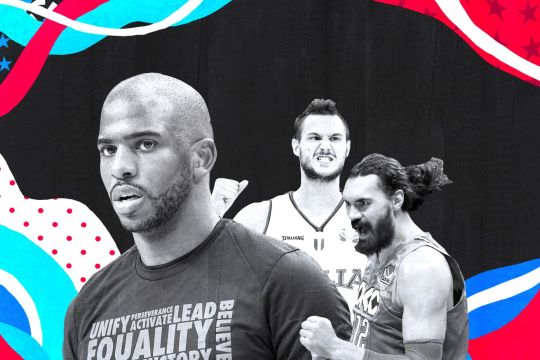
The new-look Thunder are full of possibilities.
The Thunder can be competitive even in a rebuild.
In early July, Paul George was two months removed from his 29th birthday and had just wrapped up the best season of his career when he requested a trade from the Oklahoma City Thunder. He was one season into a four-year deal. Overnight, Oklahoma City’s immediate championship goals died.
Russell Westbrook was dealt to the Houston Rockets one week later, and even though Sam Presti’s combined return was held in high regard, it also helped create two new superpowers in Los Angeles and Houston that instantly showed how wide the gap between the Thunder and a title is. It reminded him, a general manager who’s acquired and lost James Harden, Kevin Durant, George, and Westbrook, how easy it is for carefully laid plans to implode.
Oklahoma City just lost two All-NBA players in their respective primes. They’re set up for a rebuild. But instead of tanking towards ground zero, the Thunder should go the other way, be as competitive as possible, fight for a playoff spot (a long shot but FiveThirtyEight currently gives them better playoff odds than the Portland Trail Blazers and San Antonio Spurs), and reassemble on the fly.
In an NBA that seemingly changes every month, the Thunder can (ironically) take a big-picture page from the pre-Harden Rockets, tread water, and stay in the perpetual hunt for whichever young star next wants out, be it Karl-Anthony Towns, Devin Booker, whoever. Until then, they can afford to endure middling outcomes, knowing they already have one 21-year-old blue-chip guard and a larger collection of trade assets than anybody else.
Tanking isn’t in their best interest, particularly when it’s unknown how their fanbase will react to a first dip into irrelevance
Before we go on, let’s summarize what the Thunder actually received this summer: Chris Paul, Danilo Gallinari, Shai Gilgeous-Alexander, three unprotected first-round picks from the Clippers (in 2022, 2024, and 2026), two first-round picks from the Miami Heat (unprotected in 2021 and lottery-protected in 2023), and two top-four-protected first-round picks from the Houston Rockets (in 2024 and 2026). As a cherry on top, there are four additional pick swaps, with LAC in 2023 and 2025, and Houston in 2021 and 2025. There’s also a top-10 protected first-round pick in 2020 from the Denver Nuggets, who traded it for Jerami Grant.
That’s three quality players, eight first-round draft picks, and four pick swaps spread out over seven years. Not bad! For reference, the Boston Celtics received three unprotected first-round picks, one pick swap, and Kris Humphries, Gerald Wallace, Kris Joseph, MarShon Brooks and Keith Bogans for Kevin Garnett, Paul Pierce, and Jason Terry.
The Celtics wisely used those draft picks as a safety net. They were bad and had no choice but to build themselves back up through the draft, but eventually they made moves to get better in the short-term and straddle two separate timelines. The Thunder can aspire to do the same thing, but—even in a Western Conference that’s never been so punishing—the difference is they may already be good enough to avoid an intentional nosedive.
Assuming they hang on to their veterans, Oklahoma City can be the type of team that rarely beats itself, with more shooting than its recently had, and emboldened contribution from supporting pieces. Most of them are, to varying degrees, established, confident, proud, and growing. Much of their success will ultimately depend on Paul—who’s 34 and hasn’t made an All-Star team since 2016—and how the organization adjusts to such a stark stylistic modification at the point guard position. The downshift from Westbrook’s merciless house fire to Paul’s methodical slow burn may do good for a group that’s viewed chaos as a savior over the past few years.
If Paul ran a successful pick-and-roll while simultaneously typing an email into his iPhone, nobody watching would blink.
The argument for flipping Paul, a psychotically competitive Hall of Famer who’s entering his 15th season, is pretty straightforward. He’s guaranteed $124 million through 2022 and the only player set to earn more money this season is Steph Curry. It’s a bloated salary on a bloated cap sheet. But it’s hard to see any team taking that contract off Presti’s hands without some sort of compensation. (Remember, the Rockets surrendered two first-round picks to get off it.) Also, if winning as many games as they possibly can is the mandate—which it should be—keeping Paul is common sense.
Even though that contract doesn’t align with Paul’s current status, this dude isn’t exactly washed up. Now detached from Houston’s unique, isolation-obsessed approach, there’s an opportunity for Paul to conduct an offense that makes better use of his vision. Three years ago, over half his possessions were finished as a pick-and-roll ball-handler. Last season, they dropped down to 36 percent. Existing as second-fiddle to a perennial MVP candidate will do that, but it’s still a shame to see such blinding skill be underutilized. If Paul ran a successful pick-and-roll while simultaneously typing an email into his iPhone, nobody watching would blink.
Last year, he finished third in assists and averaged 22.5 points and 12.5 assists per 36 minutes when he did not share the floor with Harden. If he’s able to deep-pressure massage the game’s tempo as he has in the past, the Thunder can temporarily make themselves over with a floor general who props those around him up instead of it being the other way around.
Oklahoma City has finished top-five in transition frequency five years in a row—in their entire existence their lowest ranking was seventh—but this year their possessions will be timed with an hourglass. They won’t rely on frenetic pace induced by a rabid, turnover-forcing defense that was addicted to scrambling.
A leisurely approach that defies the rest of the league’s desire to operate at warp speed can be beneficial, for the sake of developing a sensible identity, if nothing else. Instead of crashing the offensive glass, they can be more conservative, hustling back in transition and letting Steven Adams settle into a more natural drop coverage against pick-and-rolls. Attempts at the rim—of which the Thunder have historically surrendered far too often—will drop and long twos will rise. Their quickness and versatility on the wing is convenient, too, particularly if Andre Roberson looks like his old self. (Don’t sleep on them as an Andre Iguodala suitor, either.)
On offense, more ball movement and a steady half-court hand, something Oklahoma City hasn’t employed since Kevin Durant left, won’t be taken for granted by the Thunder’s coaching staff. By finally implementing a new system that better reflects their personnel, shots can be delineated with care. While Paul memorizes every one else’s lines, Westbrook crumples the script into a ball and tries to swallow it. Both are control freaks who like to place their hands around the neck of a possession and squeeze until it turns blue, but Paul does it with a certain charm. He empowers those around him in a way Westbrook does not, and has immediate value off the ball, thanks to his three-point stroke .
Beyond Paul, this team has a few useful players who’ve peaked at a rung just below All-Star consideration, and none overlap. Last season, Gallo solidified himself as an appealing stretch four who 1) plays defense, and 2) draws fouls. He’ll space the floor beside Adams and create his own shots whenever plays break down.
And as someone who, in many ways, is the most important player on the roster, Shai Gilgeous-Alexander — the No. 11 pick in the 2018 draft — will nestle in as more of an active participant than subtle observer. As a 20-year-old rookie he pulled off the impossible last year, cementing himself as member of Doc Rivers’ regular and postseason rotation, averaging 10.8 points, making over half his two-point shots, and appearing in every single game. (He was one of 21 players in the entire league to do that.) Gilgeous-Alexander is a 6’6 rubber band whose herky-jerky, meandering drives (often with his left hand) tend to confuse help defenders even more than his own man. Will he skip to the rim, pull back and settle into a pull-up jumper, or fire a cross-court pass?
He needs to be more of a threat behind the three-point line, but his first season was filled with promising samples of a player wise beyond his years, taking what the game is willing to offer. It’ll be interesting to see how much his growth raises the Thunder’s floor and ceiling, considering he’ll have the ball in his hands far more than he did on the Clippers. (Gilgeous-Alexander may also be someone other players—really good ones!—will want to run with someday.)
Depth is an issue, as Mike Muscala and Nerlens Noel are one-dimensional in contrasting ways, while Terrance Ferguson and Hamidou Diallo are absurd athletes who provide more questions than answers. Dennis Schroder is a nightly wild card but also a possible trade chip, should the Thunder want to add more size. And even though first-round pick Darius Bazley is a project, the organization is high on what he brings to the table.
If none of this works, and Oklahoma City falls far behind Sacramento, Dallas, and Minnesota before the All-Star break, Gallo’s expiring contract will be shopped around. But before any games have been played, this intriguing underdog deserves some respect. Tanking isn’t in their best interest, particularly when it’s unknown how their fanbase will react to a first dip into irrelevance. They already have assets. They already have good players. The West is a monster, but for the time being it makes sense for the Thunder to try and slay it.
0 notes
Text
How to Clear, Charge and Program Your Crystals to Manifest Your Desires

November 19, 2018 by Savannah
I’ve been dabbling with crystals for years. I know a lot of basic stuff but not enough to give you the sort of information I’d like. I have a friend, however, that knows a TON about crystals. They’re a career area of hers and I’ve asked her to help me out on this post so that you get only the best info!
Chelsey Perry is a Reiki Master and Clinical Hypnotherapist who, during her travels, has spent many years studying minerals, crystals and gemstones.
Crystals collect energy and information and project it back into the world around them. This information needs to be cleared (in most crystals) because they pick up negative energy as well and you don’t want that lingering around. Keeping them clear will help them work better for you.
We are not owners of these crystals, they will outlive us by many lifetimes. We can temporarily be their guardians and take great care of them. Leaving our imprint on them to pass on to the next generation
To Clear Your Crystals:
Place in the window sill under a new moon
Bury in dirt overnight
Place in a salt water bath
Placing them in a bowl of salt
Sage them with the smoke
Hold them and send the intention of clearing them, into them.
If you practice healing methods such as Reiki you can hold your hands out and send energy to them with the intention of clearing. This also allows you to store energy within them that will pass to others if they touch or come near them.
If you have a geode or druze, you may place other crystals within it for 24 hours. Geodes have the ability to absorb energy that is placed within them. Its almost like a mini vortex of energy that exists within geodes themselves.
Snow
If they’re water soluble, this will damage and destroy them. Instead, place them in a dry jar and place the jar in a bowl of salt water.
To Charge Your Crystals:
Place in a window sill under a full moon
Hold them and recite your intentions
Reiki – you can write the symbol on a piece of paper and lay the crystal on top of the paper overnight or just use your hands and send the energy and intention straight to the crystal.
Drum circle (sound vibrations)
Lay them on or within a circle of salt under the moonlight if it’s not a full moon
Surround your crystals with plants for a full 24 hours or longer if you can. This allows nature to charge and cleanse your crystals for you. After all, its mother earth that created them to begin with.
Power of thought is one of our greatest strengths. You can send thoughts to the crystal you are charging and that alone can be enough.
Direct sunlight.
Direct other crystals that have been cleared or charged, at the intended crystal.
River water or natural spring water. Just don’t lose them.
You can base your charging method on what you’ll be using the crystal for. All methods work but sun energy is going to be different from moon energy. Water energy different that earth energy.
Sun energy – Success, Vibrance, loud, masculine, yang
Moon energy – Feminine, quiet, serene, calming, yin
Earth energy – grounding, solid, prosperous
Water energy – emotions
Just to name a few. You’ll see overlaps in some like sun and fire or moon and water. Trust your intuition.
Crystals That Fade in the Sun:
Amethyst
Citrine
Aventurine
Aquamarine
Beryl
Kunzite
Selenite
Sapphire
Flourite
Rose Quartz
Smokey Quartz
These aren’t the ones you want to charge with the sun or leave in the window sill. Colour is vibration so their fading will affect their abilities and uses.
Water Soluable Crystals:
Selenite
Angelite
Turquoise
Kunzite
Kyanite
Malachite
Calcite
Labradorite
These crystals are the ones that will deteriorate in water. They shouldn’t be used in baths, drinks or any other liquid-oriented methods or rituals.
Crystals That Don’t Need Cleansing:
Citrine
Apophyllite
Phenacite
Diamond
Azulite
Kyanite
These crystals don’t have to be cleared and can be used in clearing and charging other crystals.
Programming Your Crystals:
There are many ways to utilize crystals to your benefit.
Manifesting certain outcomes or things
Guidance in endeavors
Writing, studying or other focus points
Aligning your chakras
Easing emotions or physical ailments
Promoting sleep or dreams
Inspiring creativity
Protection
The possibilities are endless. Program your crystals depending on how you want them to be used.
Take a moment to see which crystal you feel pulled to when you decide which subject you are focusing on.
Ask if you can work as partners from here on out until your work is done with this subject.
Trust what you get. Each crystal has different energy from different parts of the world and may be better at assisting with something else. Once you are ready to move forward, hold the crystal to your heart chakra and hold your intention.
Project your intention and wishes moving forward into it.
Close this ritual with a thank you or an acknowledgement. Whatever works best for you. I find that everyone has a slightly different method that works for them. There is no wrong way to do this. Your method will help you integrate with the crystals that call your attention.
You can take it a step further if you prefer and sage the room first, say a mantra or chant, do a drum session or fill the room with white protective light.
Just make sure you are clear on your intention and keep the crystal close to you when you are doing the work you specified the crystal for.
https://earthandwater.co/how-to-clear-and-charge-your-crystals/
0 notes
Text
Temporary Freedom
I can’t quite describe the sound of a car starting. A vroom does not quite cut it. A chug- chug- chug is what happens when the car fails to start, or nearly fails. There is a kind of hitch, and pshh and then a low purring and a rolling of the r’s. There’s no singular sound that I can write that quite describes the sound of that hitch, pshh and purr. hi-pshh-purr. hII-psh-pururur. The sound is familiar to all of us, yet it is not easy to describe. Perhaps because we never really have to.
For some, hearing that sound can mean freedom. After walking up the long hill from the kitchen, slowly unbuttoning the top buttons near the neck, and yanking the shirt out from under the entrapment of pseudo-belt/apron rigged around through the loops of the pants all I can think is freedom. Gravel crunching under the soles of the shoes, opening the car door and trapped latent heat pouring out and sitting on the hot seat is freedom. To wrench off tight shoes and peel now-gross socks from my feet is freeing. Slamming the door, rolling the windows down and to pressing my bare feet against the brake and the clutch while turning the key is all to hear the familiar hII-psh-pururur, the sound of my freedom. My red freedom-chariot absconds from the gravel parking lot.
Daily, I submit to this torture. I wake up at 4:30, get dressed and prepared to leave by 5 or usually by 5:15. I spend approximately 30 minutes driving to work, and on certain days I take the long way around to pick up my co-worker. Arriving at work by 6:00, I go down to the nearly empty kitchen. Greet the young, sourly judgmental chef named Kyle as he putters around and start the coffee, I admit though, I preferred the days where the French sous-chef Sylvain started with me.
Then I start flipping over cups and putting out the little things: flowers, carefully piped whipped butters, house made jams, salt and pepper shakers. Carefully align the silverware- spoon with a knife facing inward on the right side, forks on the left- expensive, polished glassware -Simon Pierce water glasses positioned off the mat above the knife and spoon- and the mats on which they rest, making sure that the leftmost mat always overlaps the one on the right. Then grab the stack of identically folded napkins and place them in the same identical position on every mat. Thankfully, it is raining, and I don’t have to move these all outside and put up the umbrellas.
As I do this, the housekeeping ladies come in to clean and fill the fireplaces with wood - because only rich people would ask to have a fire in the summer- as well as vacuum the crumbs from dinner last night. After they are done rearranging the chairs to vacuum and prop the hose into the housevac with the chairs, I move them all back and inspect each chair pillow for the correct amount of fluffiness. Then it’s time for the continental. The coffee is freshly brewed just in time for me to empty it into polished silver carafes, and carefully arrange pitchers of cream, milk and almond milk beside carafes of coffee, decaf coffee and hot water. Add a wooden tea box, expensive Farmhouse Pottery mugs and honey as well as napkins and it is almost ready. Finally, stacks of newspapers on the table opposite of the Barn Room with the Times, the Boston Globe and Wall Street Journal. Seriously, I don’t know anyone who reads the Wall Street Journal, must be a rich person thing. Also, if these people are here to visit Vermont, they should have a copy of the Herald or the Valley News, right? Incorrect, only one visitor that entire summer asked to have a local paper with his daily morning room service of coffee and pastries. Still, if I am lucky, and my early morning partner competent, I should have a few moments to read the headlines. I run into the kitchen to grab the breakfast menus and stack them on the table near the door in a perfect pile. Only then is every, single, tiny, detail is similar and perfect all before we open for breakfast at 7:00.
Driving blind is generally not recommended. Or at least, that’s what I tell myself. I can see, but the rushing air flying through the car moves my now loose hair in awkward, un-traceable flows. I could slow, but I do not want to slow my escape. I could tie my hair back again but denying my hair of the same freedoms I pursue seems contradictory. Especially now that I just allowed it to be free. I can see through changing masses of brown curls that infect my vision, just perhaps not completely.
Quickly I prepare the baskets for room services. Deftly, I check that every basket is filled with whatever the guest could possibly need. Butter and Jam go with every bread like item, half-and-half with every order of coffee as well as a sugar box, and ALWAYS water and water glasses with every room service- but not the Simon Pierce glasses, those stay in the dining room, instead we send the Ridel ones carefully wrapped up in a cloth napkin. Once Kyle or Sylvain had finished the food I would wrap it and put it in the basket before running out the door.
I didn’t love that it was raining now. Room services were not fun in the rain. At first, I had to use the map to figure out where I was on the property. The cottages were not clearly labelled “Orchard Cottage”, or “Chalet Cottage” and there weren’t signs that pointed toward where you wanted to go. When I had the pattern down though, it was amazing to drive the van around the property. For a few seconds, I had the luxury of having power. It was me versus the guest. I held their beloved coffee and buttermilk pancakes hostage. They may have the wealth and power to book a few nights at a five-star resort, but their demand for caffeine and carbs at 7:30 in the morning was thwarted by some eighteen-year-old college student from the middle of bumfuck nowhere. Of course, I had to give in to their demands, but I could’ve taken the van, ran into the woods and ate the pancakes myself.
When I would set up breakfast for guests, usually they were wearing their fluffy white bathrobes, sometimes they would ask about me to avoid awkward silences or to learn more about my backstory like I was some character in an interactive story they indulged in when they came here. The usual story was that I was working here during the summer to help pay for my college education and they seemed happy with that. The traditional idea of a hard-working girl putting herself through school usually appeased them enough to stop their questions, despite that not being the truth because it was not just me working hard. It was my entire family. My mother overworking herself, and my grandparents for taking me in. I worked fifty hours a week for something that these people could buy easily. That what was the most intimidating about these people, if they were feeling generous they could make my unending struggle go away. A couple thousand dollars was nothing to them, but it was costing me my limited, youthful summer days.
The Royalton Turnpike was a beautiful DIRT road that wound its way from Royalton to Barnard. As I left ‘the hidden gem’ that was Twin Farms, I could see the descent into ‘my folk’. Suddenly the lawns were not all well-kept, and the further down the turnpike I was the more likely I was to see the junk in people’s yards. The further away I was from Barnard the rougher and bumpier the ride got, washboard rattles were more frequent as were potholes in the road. Driving my car, I was in control. I could slow if I wanted to, but I didn’t want to. I didn’t have go with the curve of the road, but I did. I was alone, and free of anyone’s expectations. I could pump my music as loud as I wanted, I could sing at the top of my lungs in a horrible off-key way and no one would care or correct me. My performance was only for me and no one depended on me.
The only time I wasn’t running around- but with the esteemed grace and even-pace as if everything was under control- was in the rare case that I wasn’t doing room services and the kitchen wasn’t behind. Then I would stand diligently at the doors to the dining room (leaning was not tolerated). I would check my apron was straight, all the buttons buttoned then stand with my back straight, hands clasped behind me, and smile on my face waiting for guests to arrive. However, as the summer went on they depended on me more and more and that meant no more waiting for guests to arrive but rather I was the one running the show in the kitchen. The Expediter- or Expo- as we called it. I called the shots, told house-keeping whose room to clean, told servers where to take food. I went out and calmly took orders from the guests with a happy go-lucky persona that pleased them. I always never could understand this idea we portrayed: happy to serve and be there. Once a Guest asked me if I would be at dinner later after I had served them both breakfast and lunch. I told them that “unfortunately I had to go home and cook dinner for my grandparents”. They seem to forget that I am an actual human being with a family and life to go home to at 4:00 pm every day. Perhaps they thought I was just part of the furniture, that I lived here, and was part of the dining room, part of the hotel’s experience.
The longer I stayed there the less I believe I existed. I became part of the dining room, and part of the quaint Vermont existence. I became the stereotypical poor farm girl, who knew the area and could recommend good spots to go swimming. The more I served the more subordinate I became, and the more I believed in the power of these people. I became powerless. My ideas and beliefs no longer had meaning because I was meaningless in these people’s lives. They forgot me as soon as they saw me, which had never happened to me before in my life. People always remember me until I became a server.
I need the job to be free, but I need to be free from the job. I live in a world of sacrificed happiness to obtain my eventual freedom. We are taught to value freedom because once I am free I am supposed to be happy. But what happens when our search for freedom becomes the drain of the happiness I desire? We are happy as children despite a complete, utter lack of control and ability to make decisions. Once we are given opportunity to make choices what if that’s when-
I slam on the brake, and the curls littering my vision fall to the side. I can see the stop sign, the same red as my freedom-chariot, bright in the afternoon sunlight. The engine sputters and stops.
I sigh and push the clutch in as well and turn the key. The familiar HII-pshh-PUurur sound enters my mind. The sound of temporary freedom.
#Look I tried to braid ideas into this and here I am#Freedom#Temporary Freedom#Freedom Chariot#Creative Writing
0 notes
Text
Optical Effects in User Interfaces (for True Nerds)
How to make optically balanced icons, correct shapes alignment, and perfect corner rounding. An illustrated guide.
Our eyes are weird organs that often tell lies to us. But if you know the peculiarities of human vision, you can construct more approachable and clean designs. Not only do type designers utilize optical tricks for creating readable and well-balanced fonts, but it’s also helpful for interface designers, who build user-computer interaction.
In the 1920s the Gestalt theory of visual perception was developed. It explains how our eyes process different images and how our brain interprets them. You might have already heard about such things as the principle of proximity or the common fate rule. This article refers to some points of the Gestalt theory and highlights practical aspects rather than scientific research. There is a list of recommended materials on the topic at the bottom.
1. Measured and optical size
What is bigger: a 400-pixel square or a 400-pixel circle? Geometrically speaking, their width and height are equal. But look at the picture below. Our eyes immediately detect that the square outweighs the circle.

Here is the version with guides.
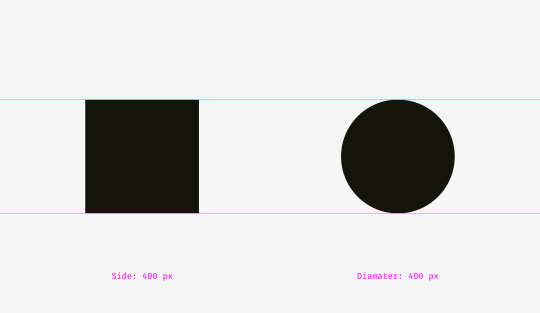
Let’s take a look at one more picture with a square and a circle. In terms of visual weight, are they equal to you?

At least it’s hard to tell immediately, which one outweighs the other. Not surprising because I increased the diameter of the circle.
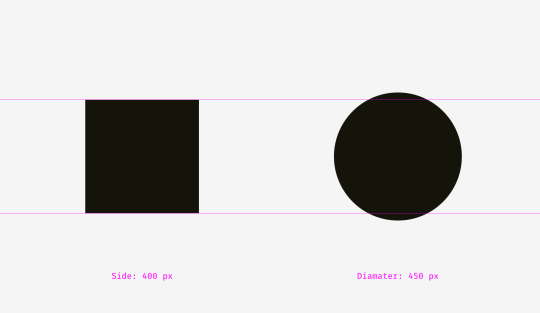
I overlapped the shapes from the first and the second examples. On the left, the 400-pixel square has bigger area than the 400-pixel circle. That’s why we see it visually larger. On the right, the circle and the square are balanced. Basically, they have similar area while their width and height are different.

We can witness the same effect with diamonds or triangles. To be balanced visually with squares, they should be wider and higher, so that their areas are similar. Area-based approach works perfect with the simplest shapes.
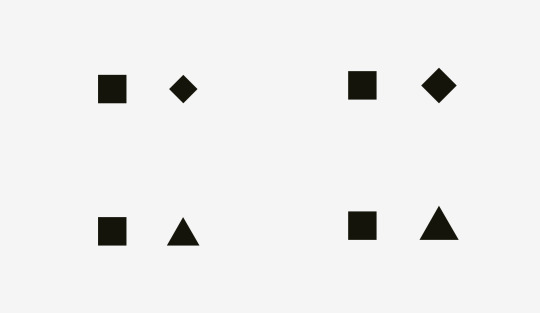
How can one use this feature in interfaces? For instance, when you are creating a set of icons, it’s important to make them all well-balanced, so that no icon stands out too much or looks too tiny. If we directly inscribe icons into square areas, the more square-like icons will look larger.
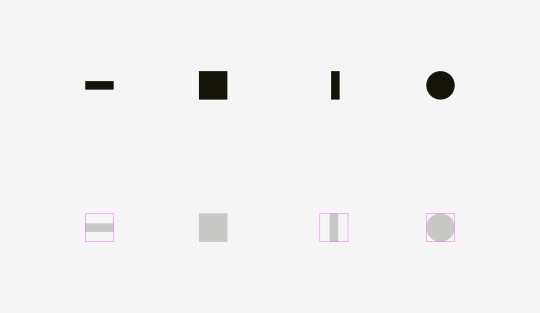
I recommend compensating the weight of differently shaped icons by allowing visually smaller icons to hang beyond the icon area and by leaving some space between visually heavier icons and the icon area.
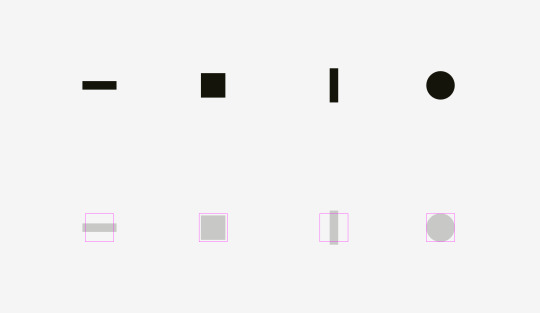
And now some real icons balanced optically.

Now it’s clear why an icon area is always larger than an icon body — just to allow non-square icons fit it and look not smaller than square icons.

The easiest test to check visual balance is blurring the items. If your icons turn into more or less similar blobs, they have the same optical weight.

But sometimes we work with already existing graphics, for instance, social network logos used as sharing and liking buttons. Facebook and Instagram icons are square, whereas Twitter is represented by a bird silhouette and Pinterest by an encircled “P”. That’s why Twitter and Pinterest icons are a bit larger, so that they look balanced with Facebook and Instagram icons.

Another example of an optical balance issue is a textbox placed together with a round button. If the button diameter equals the textbox height, the button will seem smaller to our eyes. When you enlarge it a little bit, the whole construction will become better balanced.

But if you change the style of the button, enlargement won’t be needed. On the picture below, the button and the textbox are 80 pixels high, but the button on the right doesn’t look “lost” owing to the strong black fill.

Things to remember
Optical weight is how human eyes perceive the size and significance of an object, and it doesn’t necessarily equal its pixel size or area.
Circles, diamonds, triangles, and other non-square shapes need to be higher and wider to be optically balanced with squarish shapes.
Areas for icons should have some space reserved for optical balancing. It’s crucial for sets of icons, which should look consistently.
2. Alignment of different shapes
Optical alignment is a logical continuation of the optical balance topic. Take a look at the stripes below. Do they look as if they are of the same length?

Pixelwise, the answer is a firm “yes”. However, at first sight, the lower stripe looks shorter than the upper one.
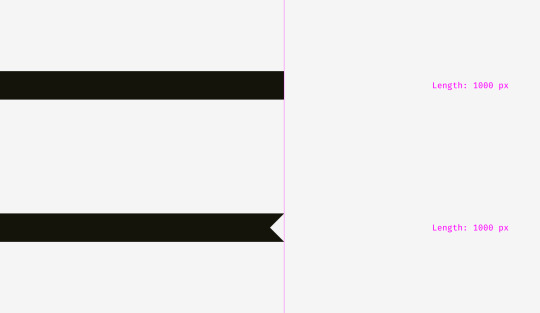
One more picture of the two stripes. Has anything changed?

I applied optical compensation for the lower stripe. Allowing the spikes to go 20 pixels beyond the length of the upper stripe is the way to compensate a gap between the spikes and make both shapes optically equal.
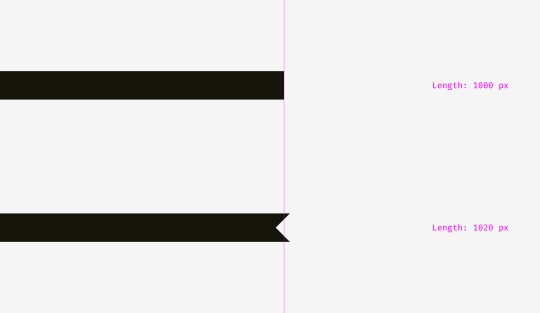
And now some more sophisticated examples of differently shaped stripes.

So, if you are creating a poster with folded stripes and text on them or you are putting a bright “discount” stripe on a product card of an online store, mind making them optically balanced. Sharp edges should go a bit beyond the rest of the shape, especially if it’s a rectangle.
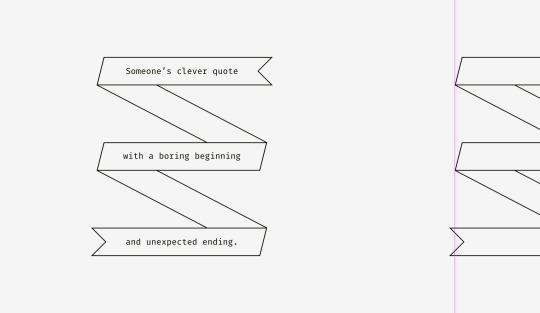
And what about aligning plain text and paragraphs that have a background? It depends on the visual density of the background. If it’s light, you can align the highlighted paragraph with the rest of text.
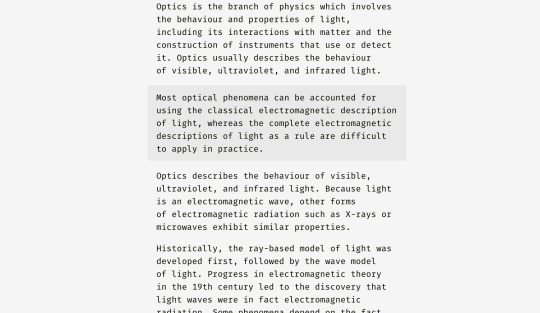
Since the background is light, it doesn’t interrupt the usual text flow.
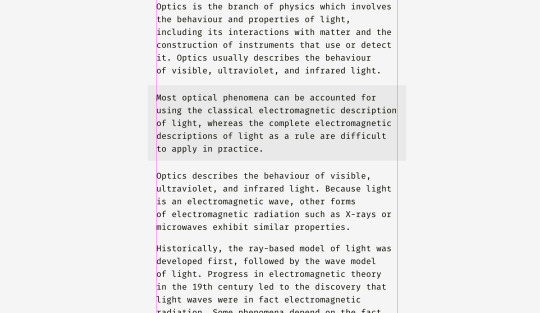
A different approach can be utilized for a dense background. On the picture, the black background is aligned with the rest of text while the white text inside of it is placed with indents.
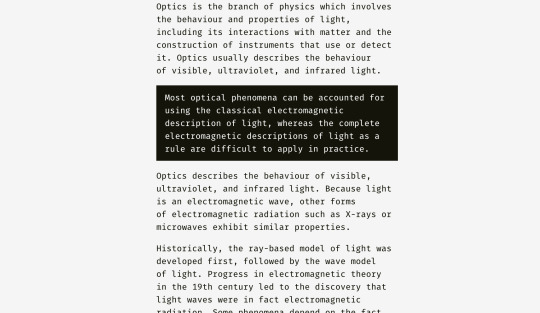
Unlike the case with the light background, the black one has substantial optical weight, and if the goal is to insert a paragraph seamlessly, it’s better to align it the way shown below.
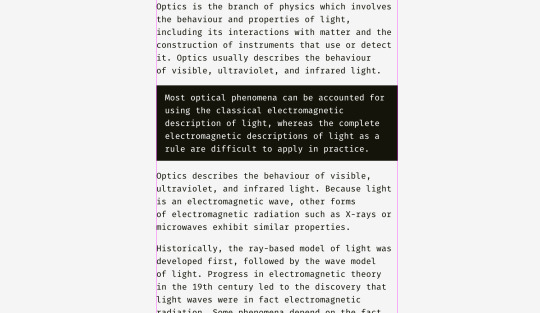
The same principle will work with buttons and input fields. Of course, it’s not a dogma, just a recommendation based on human visual perception.

The light background of input fields on the left can go beyond input labels and user’s input. The right edge of “Send” button is not fully aligned with the right edge of input backgrounds since the button is darker and looks heavier from visual perspective.
On the right, inputs have solid borders, and I aligned them with the labels while user’s input has indents inside of the boxes. “Send” button has a triangular side. The button is moved a bit rightwards to look balanced with the rectangular input fields above.
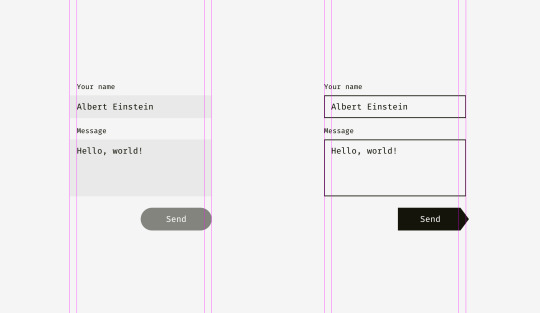
And here we are approaching to one more aspect of alignment — the alignment of text and icon buttons. Look at the buttons below. The text looks centered, doesn’t it?

The trick is that on the right button I moved the word a bit to the left, since the right edge is triangular. Moreover, the arrow-like button is 40 pixels wider to look optically equal to the rectangular one.
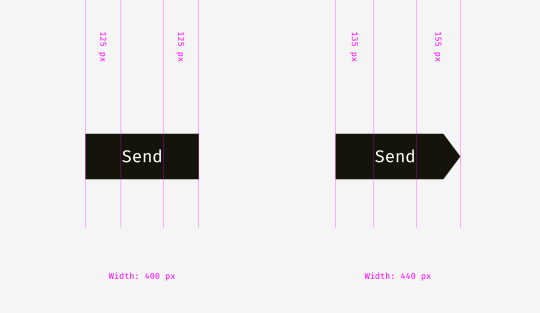
Not only do text buttons have horizontal alignment, but also they have vertical alignment of a word and a background. The first approach I’d like to tell about is used in the interfaces of various operating systems, sites, and applications. It’s the alignment based on the height of an uppercase letter of a font (so-called cap height). It equals the height of either “H” or “I”.

Basically, the space above and below an uppercase letter and the edge of a button is equal. It makes sense because command names usually are written in title case and English letters have more ascenders, upper sticking out parts (l, t, d, b, k, h), than descenders, lower hanging parts (y, j, g, p).
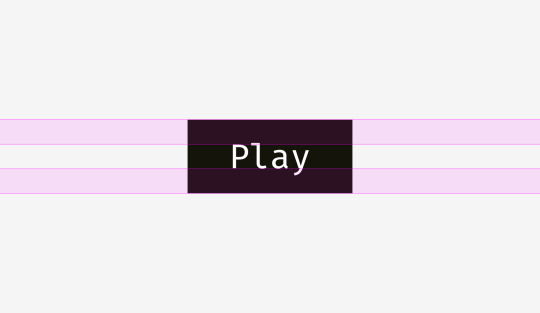
Another approach is to align a name and a background using the height of a lowercase letter of a font (so-called x-height). In sans and sans serif interface fonts, it equals the height of — not surprisingly—the letter “x”.

This approach also makes sense because the main optical weight of a text is concentrated in the area where lowercase letters are placed.
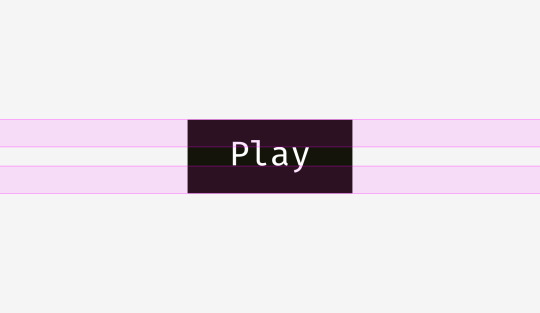
Is there any difference between these approaches? Yep, there is a difference. And it’s not that big.
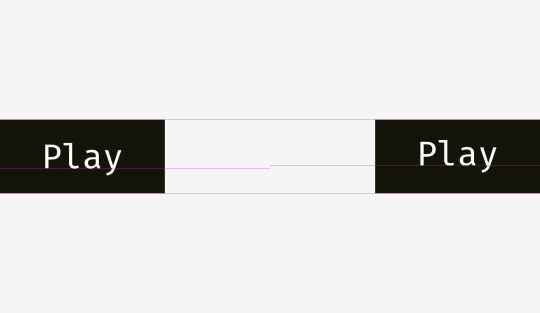
More examples for comparison below. The cap-height approach represented by the left column is definitely better for “Cancel” and “OK” — so widely used buttons — because “Cancel” has no descenders and “OK” is all capitals. The x-height approach shown in the right column is better only for “Sync” button, the name of which has both an upper and a lower sticking out elements; “Cancel” and “OK” words seem to be placed too high.
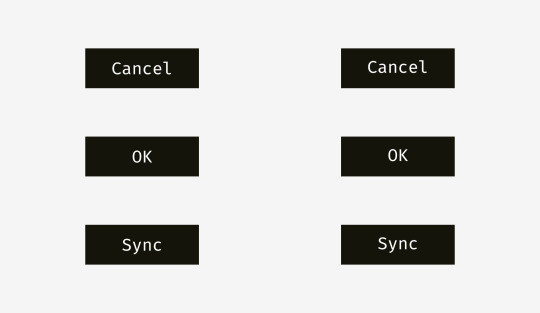
The situation with icon buttons is slightly different from text buttons. Let’s put a popular “Send” icon on a round button background. Which variant looks more visually balanced?

Hope you’ve noticed that something is wrong with the left one. It happens because of different alignment methods. The first option treats the icon if it was a rectangle. To a certain extent that’s right because when you send an SVG or PNG file to a developer it’s a rectangular sheet with a paper plane art on it. The right variant shows the icon placed the way all its sharp edges have equal distance to the circular button background.

If you prepare a file for a developer, you need to reserve some area, so that they can center the icon on the background optically right.

The same story with “Play” buttons. If you directly align these shapes — a rounded rectangle and a triangle — they’ll look odd.

If you want to position the triangle optically better, encircle it and align this circle with the button background.

Things to remember
Shapes with sharp edges should be larger or longer to look balanced with the neighboring rectangular objects.
Cap-height alignment is an effective method of positioning button names on button backgrounds.
One of the effective ways to correctly position a triangular icon on a button is to encircle it and align the circle with the background.
3. Optical corner rounding
What can be more circular than a circle? I used to think that nothing, but as I said at the beginning of this article, our eyes are weird and sometimes perceive things not as we expect. So, which circle on the picture below looks the most smoothly circular?
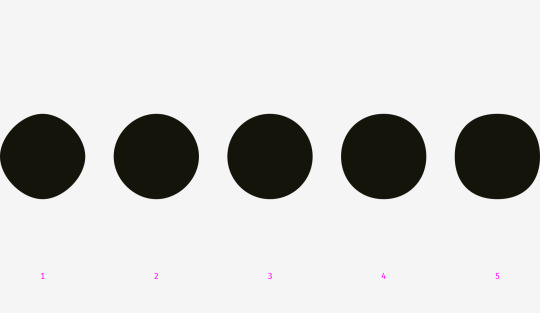
People who I asked before were choosing between numbers 3 and 4. Numbers 1 and 2 are definitely too skinny, 5 is too plump. If we overlap the third and the fourth variants — a geometric circle and a modified circle — we’ll find out that the latter is a trifle heavier than the first one and, consequently, more smooth to our eyes.
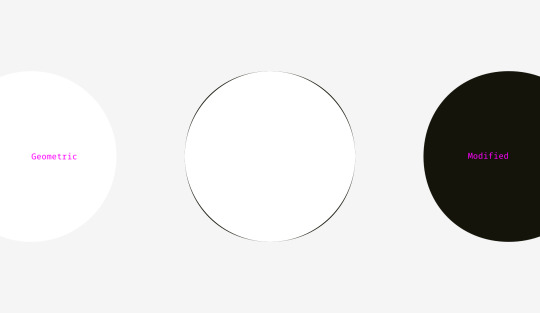
To show what I mean I took letters “o” from three famous geometric fonts — Futura, Circe, and Geometria. Given that high-quality fonts are built based on human visual perception and use a sophisticated system of optical construction, I suppose their circular shapes look more circular than geometric ones. Aren’t these letters pleasant to your eyes?
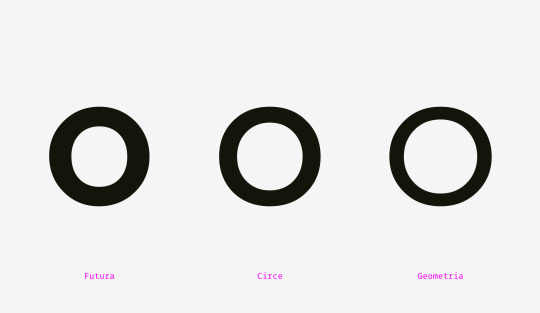
Let’s overlap them with geometric circles. Even the most geometric Futura’s “o” has four sticking out parts. Circe’s and Geometria’s letters are, in addition, wider than circles, but even if they had equal height and width, we could see these four “bellies” as if they were hungry and overate.
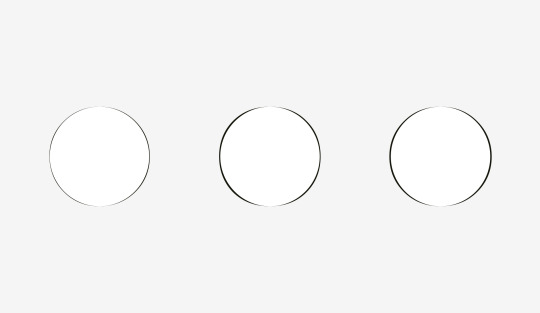
So, optically speaking, a modified circle (on the right) can look even more “circular” than a geometric one (on the left).

How can we use this phenomenon? For corner rounding, of course! If you utilize the embedded rounding feature in popular graphics editors, the result will be not optically good.

Human eyes immediately detect the point where a straight line suddenly turns into a curve. And this rounding doesn’t look natural.
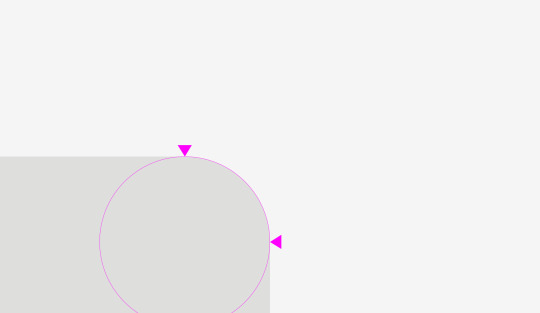
I fixed this issue taking into account our visual perception.

This kind of rounding has an extra area beyond the geometric circle making the point where a line meets a curve unnoticeable.

Just try to feel the difference between these rounding methods.

Now we can apply this approach to rounded buttons.
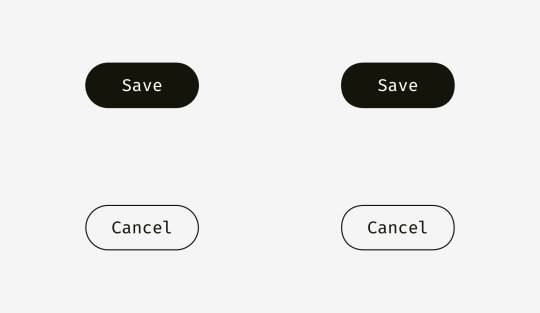
You might have noticed that the buttons on the right have more smooth corner rounding and it is more pleasant to your eyes.
The same story with app icons. One doesn’t simply use standard corner rounding to reach a perfect result. But before we dive into this topic let’s take a look at two differently rounded shapes.

The first one is a rounded rectangle, which I created in Sketch. The second shape is a superellipse, also known as Lamé curve. It was discovered by a French mathematician Gabriel Lamé and depending on the formula can vary from something like a four-pointed star to the shape looking practically as a rounded square.
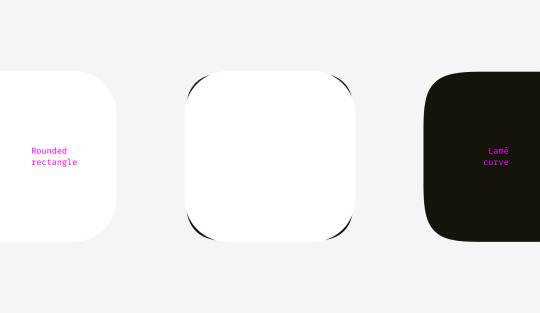
Marc Edwards proposed the formula of Lamé curve that resulted a smooth and optically perfect shape. Icons starting from iOS 7 are based on it.
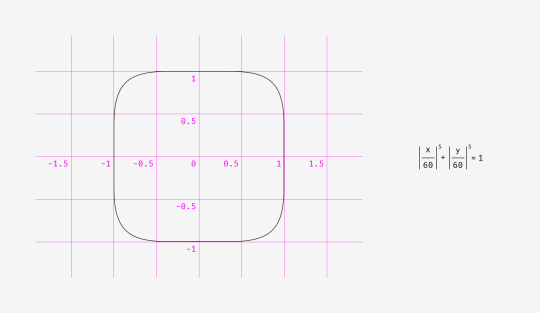
Later this shape was modified by adding golden ratio proportions and a grid for guiding the designers of new icons but that’s a different story.

The main benefit of using shapes like superellipse is their smooth appearance. On the other hand, these non-standard shapes are difficult to insert into a real interface. One should either combine multiple SVGs, include special formulas or scripts into the code or use PNG masks like Apple does for its app icons.
As for design process itself, there is a simple fix for rounded corners. You need to convert revertible rounding effects into an outline, enter the shape editing mode and manually move curve handles closer to each other.
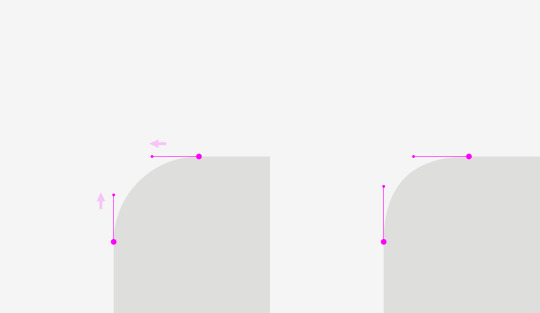
The difference is even more vivid with acute angle rounding, which is important for drawing road or metro schemes.

Things to remember
Geometrically rounded corners look artificial because you can easily see the points where a straight line suddenly turns into a curve.
Optically correct corner rounding needs special formulas or manual adjustment of a shape.
Bonus
Sometimes a not ideally geometrical square looks more squarish. You might think, “What a ridiculous nonsense?” So, what do you think about the squares below? Which shape looks more squarish?

If you’ve chosen the left shape, you’ve managed to hear the voice of your unbiased visual perception.

I personally was surprised when learned that our eyes are more sensitive to the height of an object than to its width. It explains why even in geometric fonts, letters “o” are always wider than geometric circles, and the vertical stems of letters “H” are always thicker than the horizontal ones.
Recommended reading
This essay provides a limited understanding of the topic, so I encourage you to keep on exploring it. Here is a list of articles and books about the origins of Gestalt psychology and its initial ideas.
Barry Smith, “Gestalt Theory: an Essay in Philosophy”, 1988. A profound study on the Gestalt theory origin and the philosophical and psychological aspects of human perception.
Steven Lehar, “The World in Your Head: A Gestalt View of the Mechanism of Conscious Experience”, 2002. This book explains how people perceive reality. It turns out that we see not the real world but its reflection in the brain. (Chapter 1 is available online.)
James J. Gibson, “The Perception of the Visual World”, 1950 (a scanned copy, some images are low-quality). The book shows how the physical processes in our brain affect the way we see the world.
James J. Gibson, “The Ecological Approach to Visual Perception”, 1979. (A same-titled article with key ideas is available online.)
George Boeree, “Gestalt Psychology”. A brief history of Gestalt ideas.
Biographies of the founders of Gestalt psychology: Max Wertheimer, Kurt Koffka, and Wolfgang Köhler.
The post Optical Effects in User Interfaces (for True Nerds) appeared first on Design your way.
from Web Development & Designing https://www.designyourway.net/blog/user-interface-design/optical-effects-in-user-interfaces-for-true-nerds/
0 notes
Note
this just in: biological sex is not the only aspect of gender, oh my gosh how surprising. y'all act like what someone has in their pants automatically indicates exactly how they'll act and think, which is not feminist at all. y'all literally said you dont think transmen/women aren't actually men/women. good job on being "welcoming" and "positive" - while simultaneously treating trans ppl like shit. so yeah, thanks for that. (pt. 1)
And secondly, denying biological sex doesn’t deny someone’s gender. Insisting that they must actually be men/women depending on their sex does - which is what y’all are doing. Trans ppl may have some particular type of junk in their pants, may have been raised a certain way but that doesn’t make them men/women - it makes them fucking trans. (pt. 2)
Trans people experience the world much differently than cis ppl do, and our brains function and are chemically different to someone who’s fine with their assigned gender. The science behind this is there, and there are several studies which suggest that the brain structure of trans ppl is entirely unique to them, just like it is for men and women. (pt. 3)
Actively denying trans ppl’s gender - by saying stuff like, “well, they’re actually just a man/woman” does actually hurt them. It does actually get us killed. Bc you know who else says that? The guy that murdered a trans woman who fucked him and now thinks he’s gay. The parents of trans teens who deny their child’s gender, resulting in depression and oftentimes suicide. (pt. 4)
I’m not saying you shouldn’t talk about biological sex - of course that is important. I’m just saying there are ways to do that without calling transmen “females”, and transwomen “males”. Surprise surprise you can talk about biological sex and how it affects people without automatically assuming that everyone with that junk is a woman/man - and triggering dysphoria and possibly trauma. (pt. 5
Examples of treating people like more than just their junk include - talking about specific body parts without calling their owners any pronouns, ex. “People with vulvas” “people with prostates” etc. actually talking to trans women, and men to see how they feel about this. As a trans person, it makes me feel like shit to hear you say I’m not a man - but it’s not surprising either. (pt. 6)
A majority of the population thinks I’m not actually a man, so you’re not particularly special. Most people don’t give 2 shits about people like me, or they just dislike us/want us killed and gone. You know how many times I’ve been called a “fucking tranny”, and a dyke? The answer is a hell of a lot. And you don’t get to just come in here and tell me that that’s ok because I’m actually just a woman. (pt. 7)
Reducing people to their biological sex is transphobic. You can acknowledge that someone has certain bits, but you don’t know how trans people think or feel or how being seen as just a dick/vulva feels. We aren’t just sex, we’re actual people with feelings - who wanted to be treated like actual people. (pt. 8)
I just want to say that if you being gender critical plays into a societal norm of treating trans people like they don’t exist, what makes you any different than the homophobic and misogynist politicians who want to see us dead? Maybe if being gender critical makes people lapse into depression and dysphoria, you should think about why you think it’s a good idea. (pt. 9)
Because the fact of the matter is is that this kills people. It kills young people, maybe not actively, but it still kills people. Trans teens have such a high rate of suicide because of people like you who think it doesn’t hurt to be reduced to your sex, who think it’s ok to not listen to trans people and treat them in ways that hurt - even when they've told you very specifically what is transphobic. You don't get to decide what is and isn't transphobia. (pt. 10)
So, first off: we’re using totally different definitions of the terms “male/female” the way we use it, doesn’t mean “man/woman” (as in the gender and gender roles assigned to someone) but refer to a biological reality, what sex someone is, and what sexual characteristics they have. To us, using “female” is the same as you using “afab” or “people with vaginas” It’s merely a biological descriptor, it doesn’t come with any “you should be like Y, and act like Y, and follow these gender roles” It’s just stating what “junk” (and reproductive system and secondary sexual characteristics) someone has. No more, no less.
I’m sorry that this causes trans people dysphoria and distress, I get why being reminded of their bodies, and their “supossed role in society as a man/woman” like that would (but I don’t see why “people with vaginas” is considered more acceptable? Since it also reminds you of your anatomy?) And I would recommend that if any discourse that uses these words is too triggering for you, that you disengage from it for your own well-being.
Now, cis women also suffer from not aligning with what their supposed role in society is. That’s what gender roles are, and they’re a tool of women’s oppression, which we as feminists want to combat. To be able to do that, we need to look at the roots of it, why is patriarchy the way it is? And the answer, harsh as it may be, is that it’s related to bodies and the sex of them.
Being born a certain sex means you’re treated a certain way from birth. Little girls are raised to play with dolls (to learn to be “motherly”) and wear dresses, told that they’re less intelligent and inferior to boys, and that their only worth is how attractive they’re to men. Little boys are taught to be assertive, to be strong and to be leaders. This creates a divide, a hierarchy, and what each person is taught is completely dependant on the sex of their body.
This carries on to adulthood too, and yeah, there may be nuances, a non-passing trans man will be a lot more catcalled on the street than a trans man who passes as male. The same way, a non-passing or closeted trans woman (that’d be read as a cis man) may not experience misogyny BUT a passing trans woman will. And this is all because of the way misogynistic men assume what sex you are based on how you look. This is all because they see you as “female/afab” and that makes you a target for misogyny.
Now, I’m not gonna say that if the hypothetical passing trans woman I talked about revealed she was trans (so of the “male/amab/people with penises” sex) that was going to make people treat her like a man. Because society is transphobic and misogynistic and they’d see her as a “man deviating from their assigned gender role” which they hate.
And it’s this, this misogyny tied to what gender roles you’re supposed to follow because of your body, what causes violence against trans people, violence that is very often dished out by cis men. Cis men who in no way listen to anything radical feminists have to say because if they did, they’d be against gender roles.
Now yes, this also leads to trans women internalizing some “men” behaviours, because of being socialized as boys, including sexual entitlement (as we’ve seen with the cotton ceiling discourse, that lesbians are evil if they don’t open their legs for any trans woman) and we have to analyze that, but this doesn’t diminish the violence trans people face at all, and I want to reiterate that we don’t support that.
I’m sorry that this makes young trans kid want to kill themselves, but people shouldn’t stop speaking about important things just because it hurts you (and I’m saying this as someone who has struggled with depression and with wanting to commit suicide). We don’t want any trans kids to feel suicidal at all, but we can’t just not speak about sex when it’s relevant to us and our experiences, so again, I say that if this hurts someone that much, it’s better that they disengage from the conversation.
I support trans & dysphoric people treating their dysphoria however they see fit, I support them having legal protections and rights so that they don’t get discriminated against in any aspect of life, I support them in living free from male violence, and that they enjoy the same freedoms and obligations everyone else should. Calling them “male” or “female” when talking about feminist discourse (or about sexual orientation) where someone’s birth sex and the sex they’re read as is relevant to the conversation, doesn’t suddenly contradict the above.
We merely said we’d welcome any trans men that feel they could relate to our experiences in our positivity blog, because there is and has been historically a lot of overlap between the trans men and lesbian community (many trans men used to identify as lesbians and viceversa, many lesbians have dated trans men, etc) so yeah we share common experiences because of our shared sex, and if they’re female-attracted, even more so. So we just said they’d be welcome on our blog, if any of them wanted to. It doesn’t mean we want to force anyone to take on any label they don’t want to (re: straight trans men and the label “lesbian”) it just means that if any of them felt they could relate to what we post, that that would be perfectly fine by us. But we’re not going to make anything aimed specifically at trans men.
As for trans women, I personally don’t mind if any of them follow us if they’re able to relate to what we post. I don’t like obsessively policing who follows me or who other people follow (mod m speaking here) But, again, since our blog was made to be a space for female/afab lesbians, it’s the perspective we’ll be speaking from. So we’re not going to make anything specifically aimed at trans women either, because we feel there was a lack of spaces that focused on female lesbian sexuality and talked honestly about exclusive same-sex attraction, and what that entails (because with discourse like the “lesbian are bigots if they don’t like dick” we’re becoming less and less able to talk about our sexual orientation and desires and what that entails, because other people thinks us talking about our lives is inherently evil, when it’s not meant to hurt anyone, it’s just us speaking our truth)
This doesn’t mean we hate trans people at all or wish them any ill. All we want is a positive space for us and people like us to talk about our experiences.
Mod M :D
1 note
·
View note